Table of Contents
- Introduction
- Editor’s Choice
- Speech Recognition Market Overview
- Market Size of the Global Language Services Industry
- Causes of Sense and Speech Disability
- Youths with Speech or Language Impairments
- Registered Trends in Persons with Speech Disabilities
- Individual Registered with a Primary Speech and Language Impairment
- Prevalence of Hearing Loss
- Awareness of Warning Signs of Hearing Disorders in Children
- Youths with Specific Learning Disabilities
- Youth with Learning Disabilities – By Learning Environment
- Learning Disability Inpatients Statistics
- Learning Disabilities Among Children
- Nurses Working with People with Learning Disabilities and Difficulties
- Prevalence of Speech and Language Disorders in Children Statistics
- Common Speech Disorder Signs in Different Age Groups
- The Widespread Impact of Speech and Language Disorders on Children and Adults Statistics
- Speech-Language Pathologists Statistics
- Presence of Speech and Language Therapists
- Treatments and Solutions
- Speech-based NLP Market Size Worldwide
- Revenue of Offices of Physical, Occupational, and Speech Therapists
- Initiatives to Combat Speech and Language Disorders Statistics
- Recent Developments
- Conclusion
- FAQs
Introduction
Speech and Language Disorders Statistics: Speech and language disorders affect an individual’s communication ability, impacting speech production, language comprehension, and social interaction.
These disorders can be categorized into speech disorders (e.g., articulation, fluency, voice disorders) and language disorders (e.g., receptive, expressive, and mixed language disorders).
They can result from various factors such as genetic influences, neurological conditions, hearing loss, developmental delays, or environmental factors.
Diagnosis typically involves assessments by a speech-language pathologist, and treatment may include speech therapy, augmentative communication tools, or behavioral therapy. Early intervention is crucial in improving outcomes, though some individuals may require ongoing support.
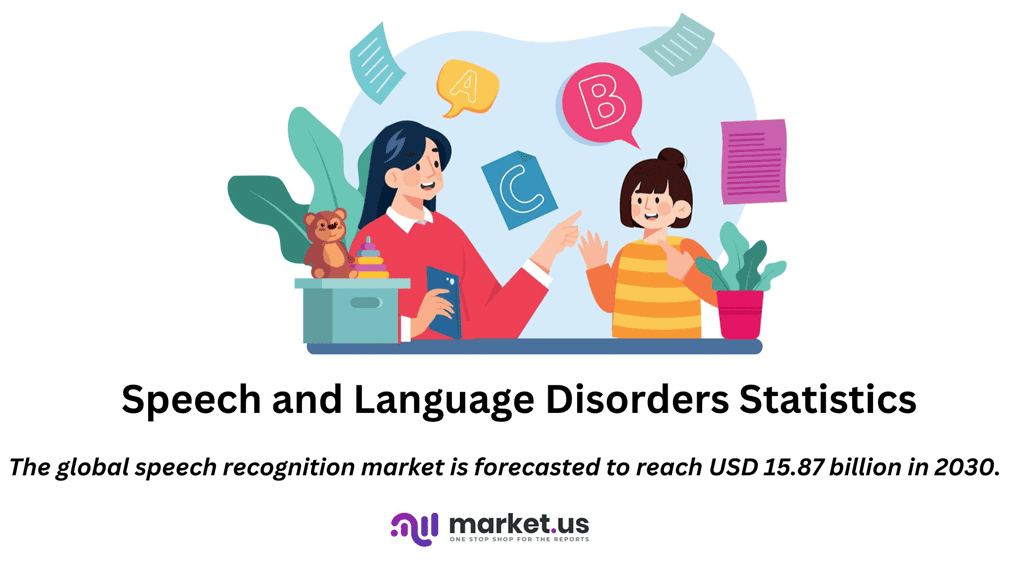
Editor’s Choice
- The global speech recognition market is forecasted to reach USD 15.87 billion in 2030.
- The global language services market size reached $56.43 billion in 2022.
- In 2018, the leading cause of sense and speech disabilities in Australia was reported as the condition “just came on,” accounting for 20.8% of cases.
- By 2050, the number of people with hearing loss is projected to reach 711 million. Reflecting the growing prevalence of hearing loss as a major global health concern.
- In 2023, only 20.8% of U.S. audiologists believed most parents recognized early signs of hearing disorders, while 75.8% said they were unaware.
- A study of 5-year-old kindergarten children in the Ottawa-Carleton region showed that, out of 1,655 children tested, 180 had speech or language issues.
- In adults, more than 3 million people in the U.S. stutter, and about 1 in 4 continue to stutter from childhood into adulthood.
- In the UK, the “Listening to Unheard Children” report by Speech and Language UK highlights the urgent need for support among 1.9 million children struggling with speech and language.

Speech Recognition Market Overview
Global Speech Recognition Market Size
- The global speech recognition market has demonstrated significant growth over the years at a CAGR of 14.24%.
- This is indicated by the market size data spanning from 2020 to 2030.
- In 2020, the market was valued at USD 2.67 billion, showcasing early adoption and integration into various industries.
- This figure rose substantially to USD 6.50 billion in 2021, marking a pivotal year of accelerated expansion.
- However, 2022 saw a moderate dip, with the market size at USD 4.76 billion. Followed by a recovery in 2023, where it grew to USD 5.59 billion.
- Projections indicate that the market will continue to expand rapidly. Reaching USD 7.14 billion in 2024 and USD 8.58 billion in 2025.
- This upward trajectory is expected to persist, with the market anticipated to grow to USD 9.94 billion in 2026, USD 11.23 billion in 2027, and USD 12.55 billion in 2028.
- By 2029, the market is forecasted to reach USD 14.07 billion, ultimately culminating at USD 15.87 billion in 2030.
- This consistent growth reflects an increasing demand for speech recognition technologies across various sectors. Driven by advancements in artificial intelligence and growing applications in consumer devices, healthcare, and enterprise solutions.
(Source: Statista)
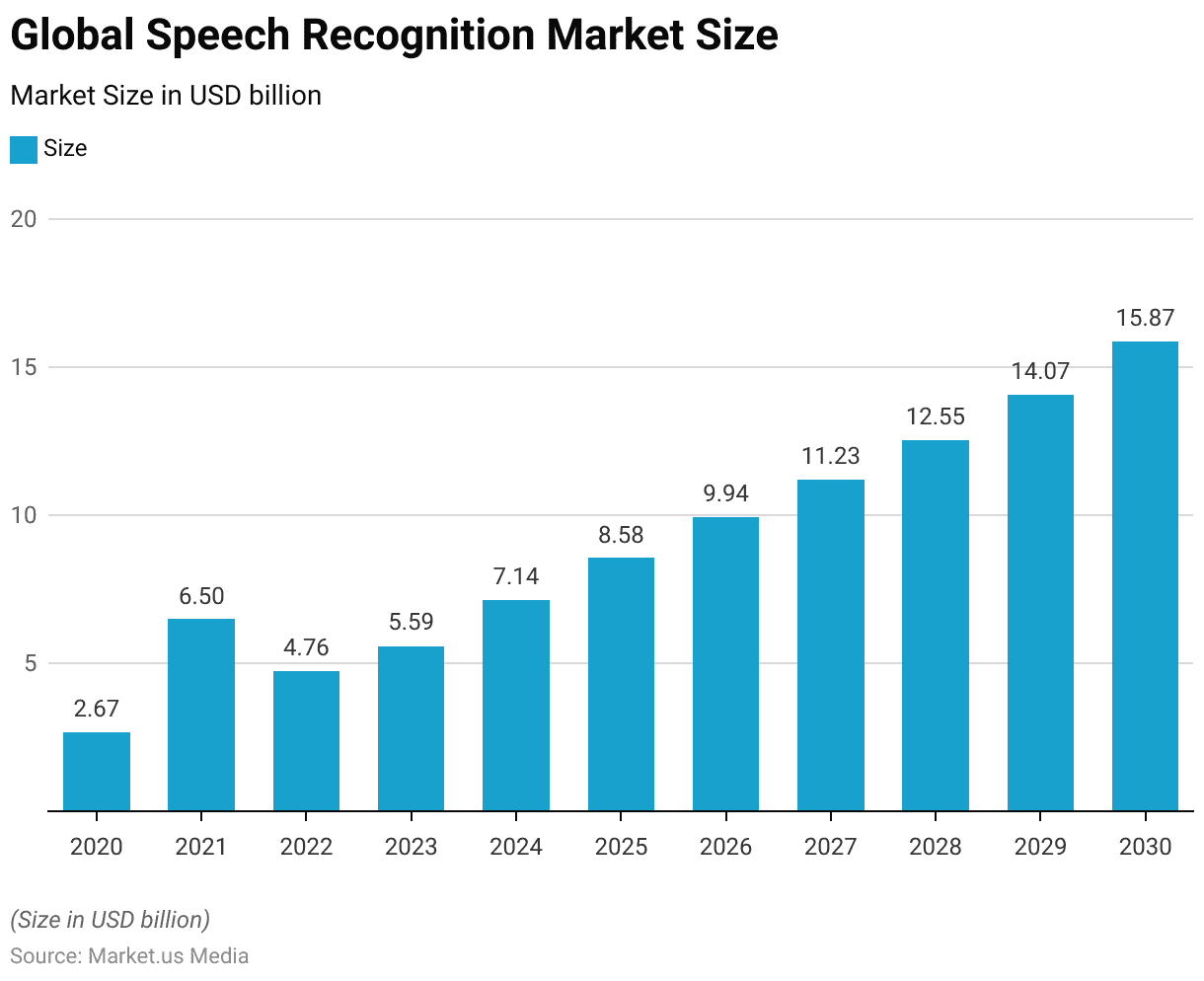
Global Speech Recognition Market Size Change
- The global speech recognition market has experienced fluctuating growth rates between 2021 and 2030.
- In 2021, the market witnessed a remarkable surge with a growth rate of 143.79%. Indicating robust expansion driven by heightened adoption and technological advancements.
- However, in 2022, the market faced a significant contraction, with a negative growth rate of –26.85%. Reflecting a temporary slowdown due to market adjustments or external factors.
- The recovery began in 2023, with a growth rate of 17.49%, followed by a more substantial increase of 27.76% in 2024.
- Growth rates then gradually moderated but remained positive, with 20.25% in 2025 and 15.82% in 2026, showcasing sustained market momentum.
- From 2027 to 2030, the growth rates stabilized in the lower double digits, with figures of 12.91% in 2027, 11.76% in 2028, 12.13% in 2029, and 12.82% in 2030.
- This trend highlights a maturing market, with steady demand growth fueled by the continuous integration of speech recognition technologies across diverse applications.
(Source: Statista)

Speech Recognition Market Revenue – By Country
- In 2024, the speech recognition market is projected to generate significant revenue across various countries, with the United States leading at USD 1,903 million.
- China follows closely with USD 1,364 million, highlighting its robust market presence.
- Japan and Germany also contribute substantially, with revenues of USD 316.70 million and USD 305.40 million, respectively.
- India is expected to generate USD 253.30 million. While the United Kingdom and France will see revenues of USD 230.30 million and USD 207.80 million.
- Russia and Canada are projected to contribute USD 167.70 million and USD 159.80 million, respectively. Followed by Italy at USD 150.40 million and Brazil at USD 143.50 million.
- Australia and South Korea are forecasted to generate USD 127.30 million and USD 125.10 million, respectively.
- Other notable markets include Mexico (USD 109.60 million), Spain (USD 106.10 million), and Indonesia (USD 98.57 million).
- Saudi Arabia, the Netherlands, and Turkey are expected to contribute USD 82.82 million, USD 75.50 million, and USD 67.70 million, respectively.
- Smaller but significant markets include Poland (USD 51.62 million), Argentina (USD 47.13 million), Sweden (USD 44.19 million), Norway (USD 43.31 million), Belgium (USD 43.28 million), and Thailand (USD 37.03 million).
- These figures underscore the global proliferation and growing demand for speech recognition technology across diverse regions.
(Source: Statista)
Take advantage of our unbeatable offer - buy now!


Market Size of the Global Language Services Industry
- The global language services industry has experienced consistent growth from 2009 to 2022.
- In 2009, the market size was valued at $23.5 billion. Which increased to $26.3 billion in 2010 and $28.34 billion in 2011.
- This upward trend continued, reaching $33.05 billion in 2012 and $34.78 billion in 2013.
- By 2014, the market had grown to $37.19 billion and further expanded to $38.16 billion in 2015.
- The industry surpassed the $40 billion mark in 2016 with a market size of $40.27 billion. Followed by $43.08 billion in 2017 and $46.52 billion in 2018.
- In 2019, the market reached $49.6 billion.
- Despite global challenges, growth persisted, with the market size projected to reach $51.94 billion in 2020, $54.17 billion in 2021, and $56.43 billion in 2022.
- This consistent expansion highlights the increasing demand for language services worldwide.
(Source: Statista)

Causes of Sense and Speech Disability
- In 2018, the causes of the main condition among people with a sense of speech disability in Australia varied widely.
- The most commonly reported cause was that the condition “just came on,” accounting for 20.8% of cases.
- Disease, illness, or hereditary factors contributed to 14.8% of cases. While 11.8% were attributed to working conditions, work, or overwork.
- Old age was identified as the cause in 10.7% of instances, and accidents or injuries accounted for 8.2%.
- Conditions present at birth made up 8% of cases.
- Less common causes included medication or medical procedures (1.5%), personal or family problems such as death (1.4%), stress (1.3%), smoking (1.3%), and war or peacekeeping service (1%).
- Other unspecified causes were reported by 5.2% of respondents. While 14% of individuals were unsure about the cause of their condition.
- This distribution highlights a diverse range of contributing factors, emphasizing the multifaceted nature of sense and speech disabilities.
(Source: Statista)
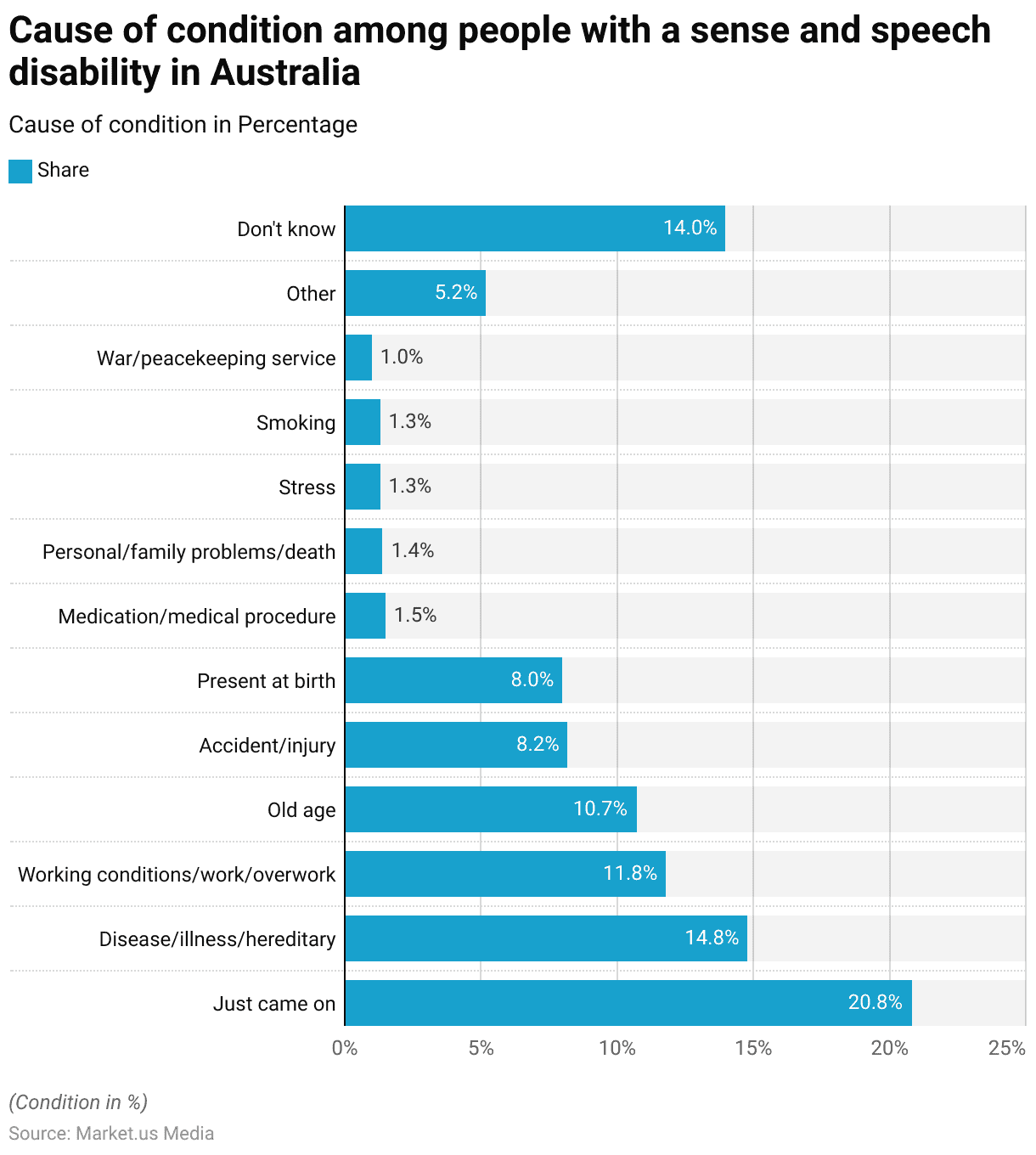
Youths with Speech or Language Impairments
- Between 1990/91 and 2021/22, the number of 3 to 21-year-olds with speech or language impairments served under the Individuals with Disabilities Education Act (IDEA) in the United States has shown notable fluctuations.
- In 1990/91, 985,000 youths were served.
- By 2000/01, this figure had risen to 1,388,000, marking a significant increase.
- The trend continued with gradual growth, peaking at 1,475,000 in 2006/07.
- Subsequently, the number began to decline slightly, reaching 1,454,000 in 2007/08 and further decreasing to 1,426,000 in 2008/09.
- From 2009/10 to 2013/14, the figures displayed a downward trend, with the lowest point at 1,332,000 in 2014/15.
- Following this period, there was a stabilization of around 1,337,000 between 2015/16 and 2016/17.
- A gradual increase was observed again from 2017/18, reaching 1,378,000 in both 2018/19 and 2021/22.
- The data reflects a dynamic pattern of service provision over the three-decade period. Influenced by changing demographic trends, policy adjustments, and educational support systems aimed at addressing speech and language impairments.
(Source: Statista)
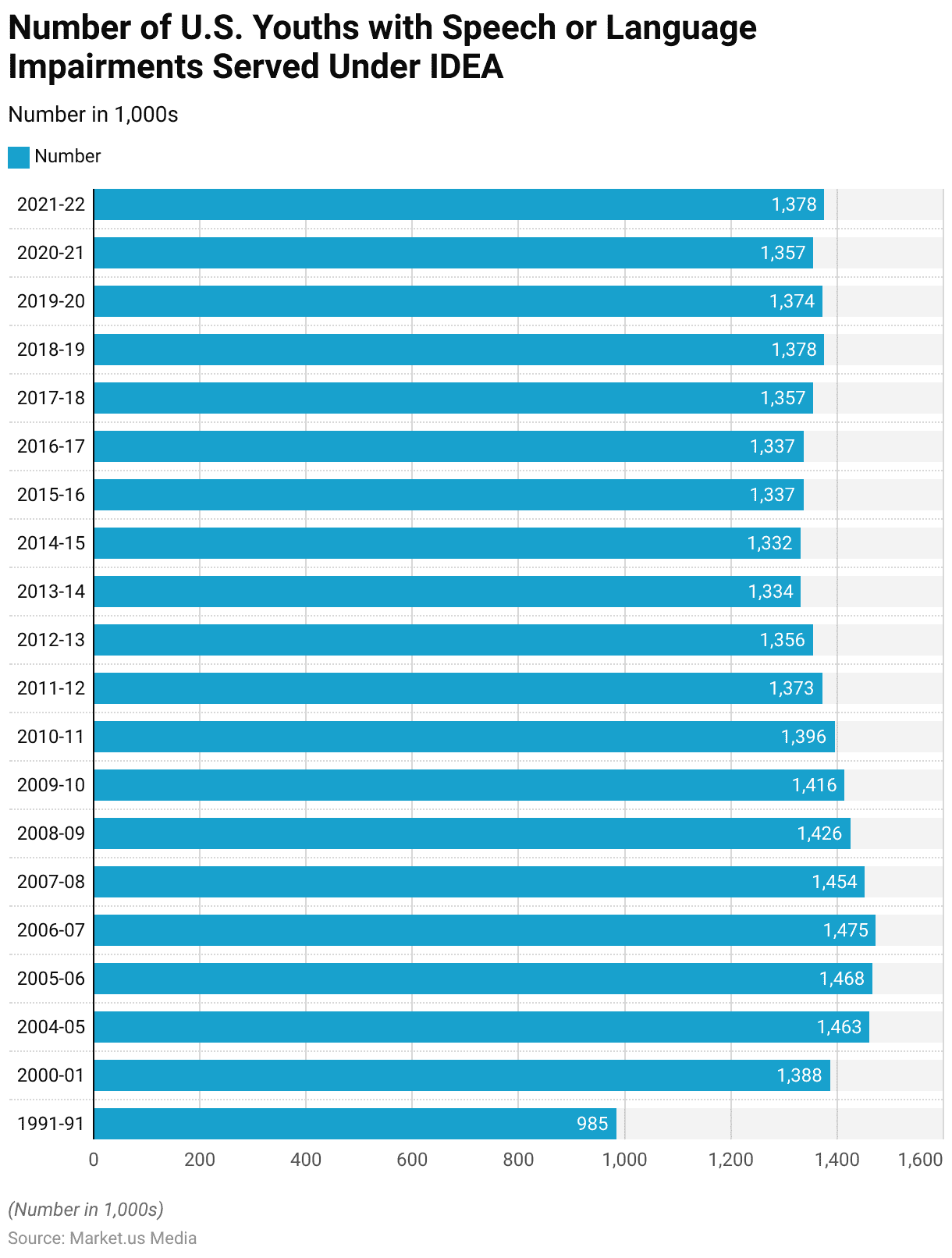
Registered Trends in Persons with Speech Disabilities
- The number of registered individuals with speech disabilities in South Korea has exhibited a steady upward trend over the past decade. Reflecting increasing recognition and registration of such disabilities.
- In 2013, there were 17,830 registered cases, which rose to 18,275 in 2014 and further to 18,813 in 2015.
- This upward trajectory continued, reaching 19,409 in 2016 and crossing the 20,000 mark in 2017, with 20,321 cases.
- By 2018, the number had increased to 20,744, followed by 21,485 in 2019.
- The growth trend persisted through 2020 when 22,391 cases were registered, and in 2021, the figure climbed to 23,064.
- A slight increase was observed in 2022, with 23,317 registered cases.
- However, 2023 saw a marginal decline to 22,830 cases.
- These figures highlight both the rising awareness and improved systems for diagnosing and documenting speech disabilities over the years in South Korea.
(Source: Statista)
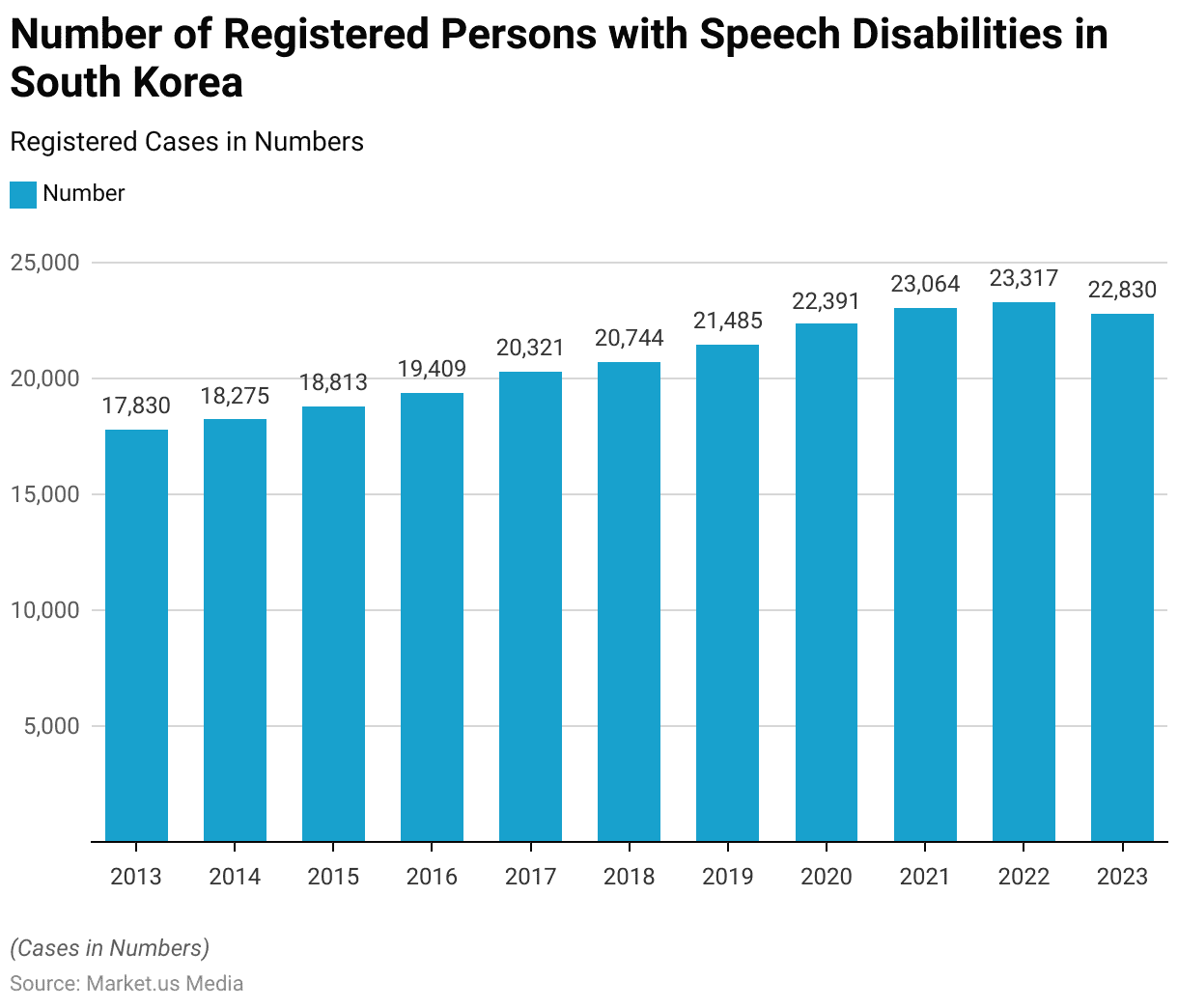
Individual Registered with a Primary Speech and Language Impairment
- Between 2006 and 2017, the number of individuals registered with a primary speech and language impairment in Ireland exhibited significant fluctuations.
- In 2006, 555 individuals were registered, marking the beginning of a notable upward trend.
- By 2007, the number more than doubled to 1,152, and in 2008, registrations surged to 2,736.
- This increase represented the highest annual figure in the observed period.
- However, the numbers slightly declined to 2,565 in 2009 and 2,527 in 2010 before peaking again at 2,714 in 2011.
- Following 2011, the number of registered cases showed a gradual decline, with 2,611 in 2012 and 2,388 in 2013.
- The downward trend continued more sharply after 2014 when registrations decreased from 1,897 to 1,979 in 2015 and further declined to 1,640 in 2016.
- By 2017, the number slightly dropped again to 1,619.
- This data reflects the evolving landscape of speech and language impairment registration in Ireland. Potentially influenced by changes in diagnostic criteria, healthcare policies, or awareness initiatives during this period.
(Source: Statista)
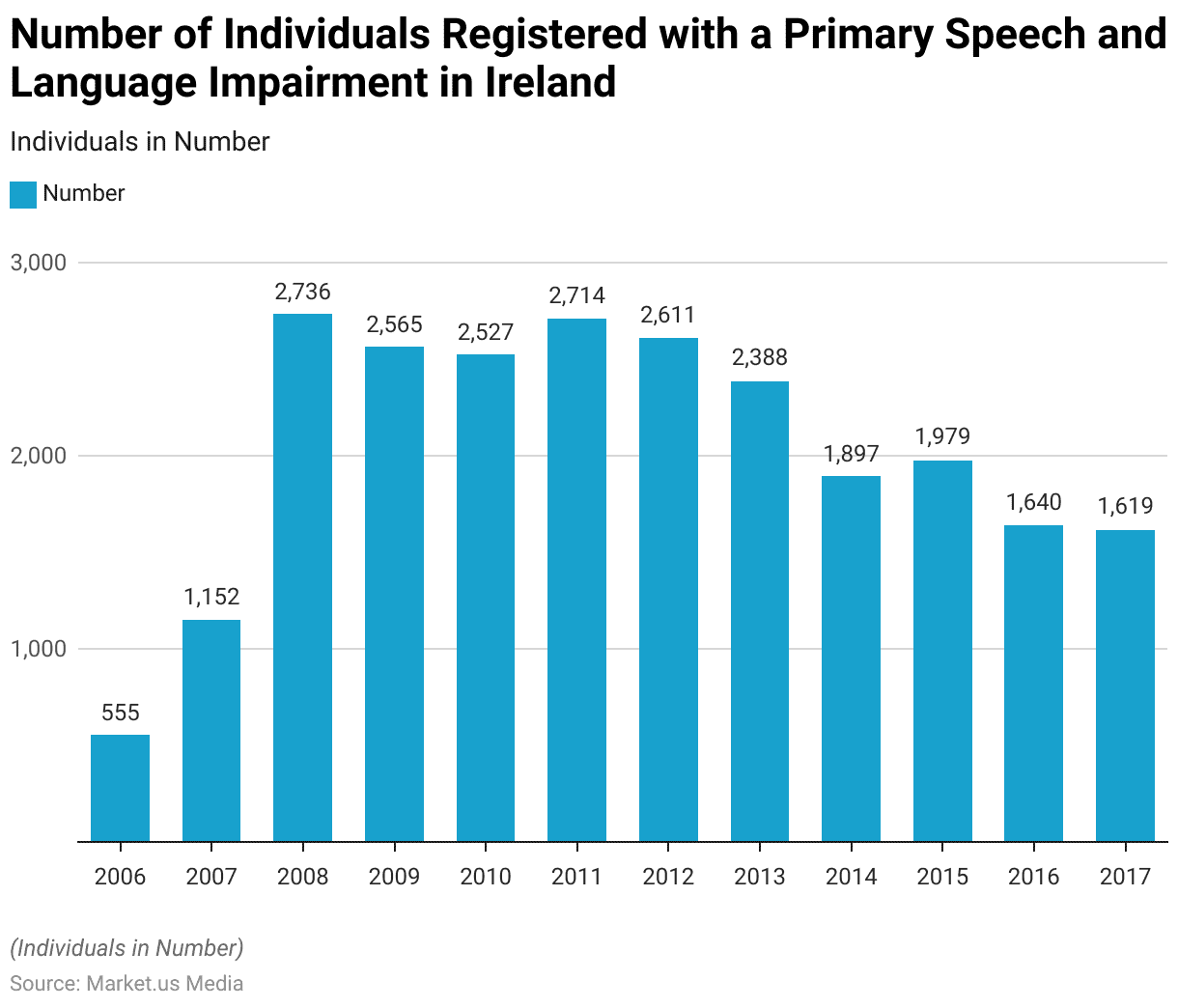
Prevalence of Hearing Loss
Number of People with Disabling Hearing Loss Worldwide
- The number of people worldwide with disabling hearing loss is projected to increase significantly over the coming decades.
- In 2019, an estimated 430 million individuals were affected globally.
- By 2030, this figure is expected to rise to 509 million, marking a substantial increase.
- Projections for 2040 indicate a further rise, with 612 million people anticipated to have disabling hearing loss.
- By 2050, the number is projected to reach 711 million. Reflecting the growing prevalence of hearing loss as a major global health concern.
- This trend underscores the urgent need for enhanced prevention, diagnosis, and treatment strategies to address hearing impairments on a global scale.
(Source: Statista)
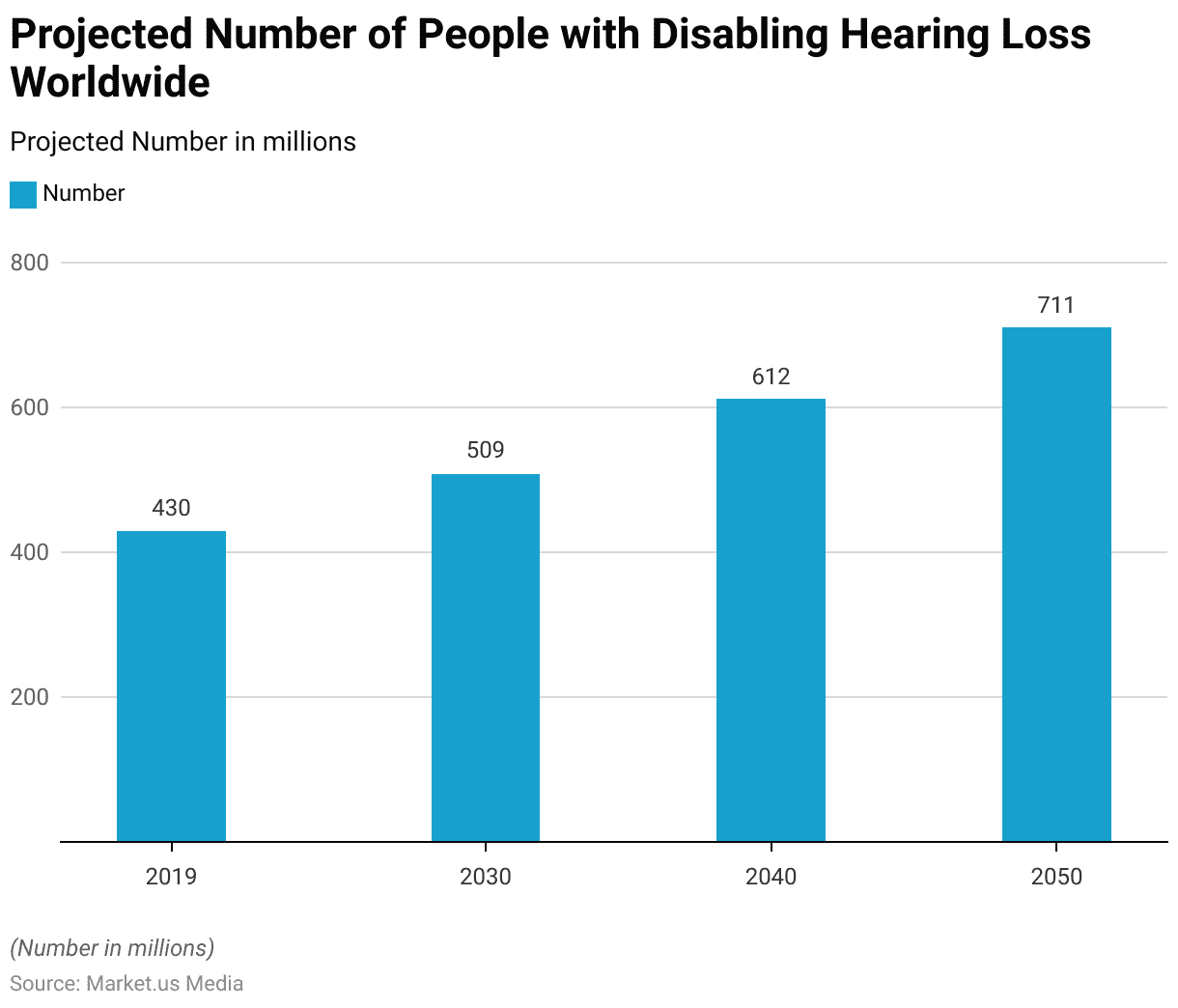
Prevalence of Hearing Loss Worldwide – By Degree of Hearing Loss
- As of 2019, the global prevalence of hearing loss varied significantly by the degree of impairment.
- Mild hearing loss, defined as a loss of 20-34 dB, was the most common, affecting 14.2% of the population.
- Moderate hearing loss, ranging from 35-49 dB, had a prevalence rate of 3.3%.
- Moderately severe hearing loss, with a loss of 50-64 dB, affected 1.1% of individuals.
- Severe hearing loss, characterized by a loss of 65-79 dB, was less common, with a prevalence of 0.3%.
- Profound hearing loss (80-94 dB) and complete hearing loss (equal to or greater than 95 dB) were the least prevalent, each affecting 0.2% of the population.
- These figures highlight the varying degrees of hearing loss globally and underscore the importance of tailored interventions to address different levels of hearing impairment.
(Source: Statista)
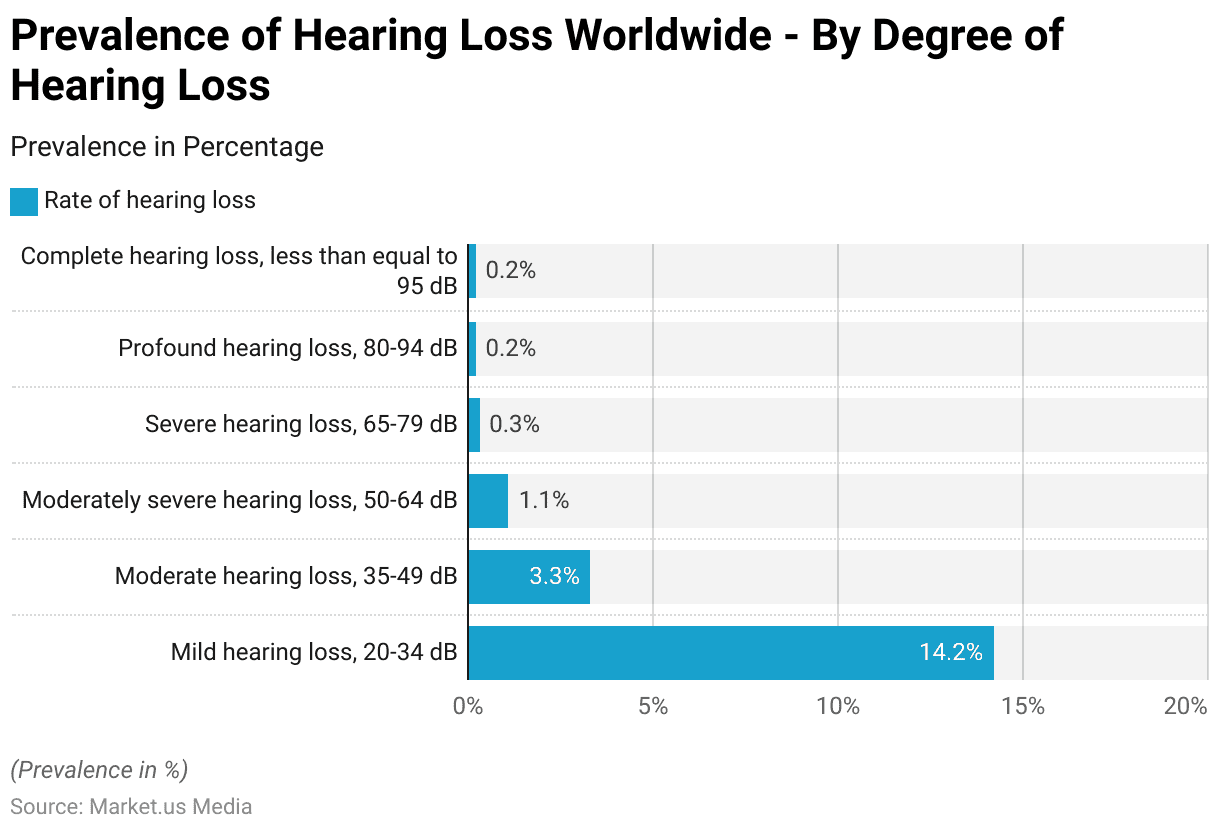
Number of People with Hearing Loss Worldwide – By Region
- The projected number of people with disabling hearing loss worldwide is expected to increase significantly across all regions between 2018 and 2050.
- In high-income regions, the number is anticipated to grow from 46 million in 2018 to 58 million in 2030 and 72 million by 2050.
- Latin America and the Caribbean are expected to see a rise from 40 million in 2018 to 56 million in 2030 and 87 million by 2050.
- The Middle East and North Africa will experience an increase from 16 million in 2018 to 24 million in 2030 and 44 million by 2050.
- Sub-Saharan Africa is projected to see substantial growth, from 49 million in 2018 to 71 million in 2030 and 133 million in 2050.
- South Asia, with the highest regional prevalence, is expected to grow from 131 million in 2018 to 176 million in 2030 and 267 million by 2050.
- Central/East Europe and Central Asia are projected to increase from 34 million in 2018 to 40 million in 2030 and 46 million in 2050.
- In East Asia, the number is expected to rise from 100 million in 2018 to 139 million in 2030 and 189 million in 2050.
- Similarly, East Asia and the Pacific are projected to grow from 47 million in 2018 to 64 million in 2030 and 95 million by 2050.
- These projections underscore the urgent need for global strategies to address the growing burden of hearing loss, particularly in low- and middle-income regions.
(Source: Statista)

Prevalence of Hearing Loss Worldwide – By Region
- As of 2019, the prevalence of hearing loss varied significantly across global regions.
- The Western Pacific region reported the highest prevalence at 21.5%. Closely followed by the Southeast Asia region with 21.2%.
- The African region also exhibited a notable prevalence rate of 18.9%.
- In the Region of the Americas, 18% of the population was affected by hearing loss.
- The Eastern Mediterranean and European regions reported lower prevalence rates of 14.9% and 14.3%, respectively.
- These figures highlight regional disparities in the burden of hearing loss. Emphasizing the need for targeted interventions and resource allocation to address the issue effectively in high-prevalence regions.
(Source: Statista)
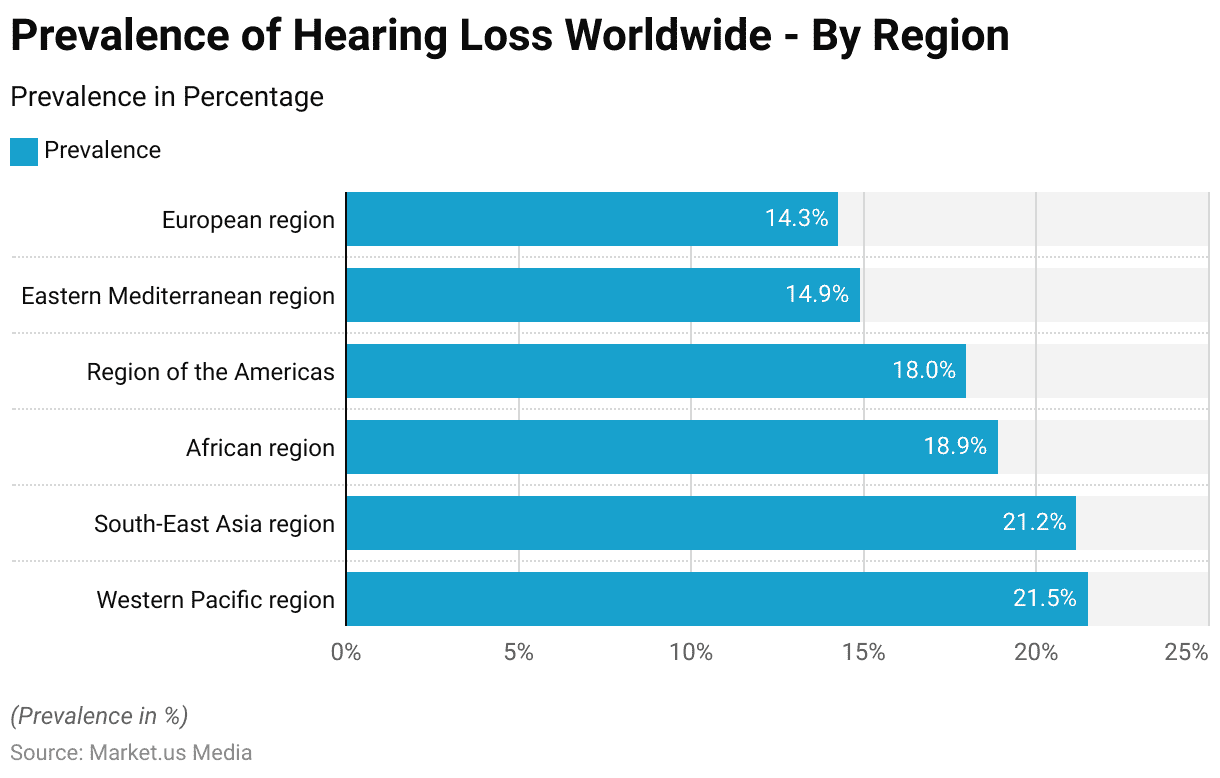
Awareness of Warning Signs of Hearing Disorders in Children
- As of 2023, a significant proportion of U.S. audiologists and speech-language pathologists indicated that most parents of children were not aware of the early warning signs of hearing disorders.
- Specifically, only 20.8% of audiologists believed that most parents were aware, while 75.8% stated they were not.
- Among speech-language pathologists, 16% felt that parents were aware, whereas 64.2% believed otherwise.
- Overall, across both professions, just 18% of respondents agreed that parents were generally aware of the early signs of hearing disorders, while 69.1% disagreed.
- These findings highlight a critical gap in parental awareness. Underscoring the need for increased education and outreach efforts to improve early detection and intervention for hearing-related issues in children.
(Source: Statista)

Youths with Specific Learning Disabilities
- Between 1990/91 and 2021/22, the number of 3 to 21-year-olds with specific learning disabilities served under the Individuals with Disabilities Education Act (IDEA) in the United States showed notable fluctuations.
- In 1990/91, 2.13 million youths were served.
- This number increased significantly, peaking at 2.86 million in 2000/01.
- Following this peak, a gradual decline was observed, with the number dropping to 2.80 million in 2004/05 and further to 2.43 million by 2009/10.
- The trend continued downward, reaching a low of 2.26 million in 2013/14.
- However, starting in 2014/15, the number began to stabilize, with slight increases observed in subsequent years, rising to 2.37 million in 2018/19 and 2.41 million in 2019/20.
- The most recent data shows a slight decline, with 2.35 million youths served in 2021/22.
- These trends highlight changing dynamics in the identification and support of students with specific learning disabilities over the past three decades.
(Source: Statista)

Youth with Learning Disabilities – By Learning Environment
- In 2022, the majority of disabled youths aged 6 to 21 served under the Individuals with Disabilities Education Act (IDEA) in the United States were placed in regular schools with varying levels of classroom inclusion.
- Specifically, 67% of these students spent 80% or more of their time in regular classes. While 15.8% spent between 40% and 79% of their time in such environments.
- Additionally, 12.5% of students spent less than 40% of their time in regular classrooms.
- A smaller proportion, 2.4%, attended separate public or private schools specifically for students with disabilities, and 1.6% were parentally placed in regular private schools.
- Only 0.3% of these students were in homebound or hospital placements, 0.2% in separate residential facilities, and 0.1% in correctional facilities.
- This distribution underscores a strong emphasis on integrating students with disabilities into regular educational settings while accommodating those requiring specialized environments.
(Source: Statista)

Learning Disability Inpatients Statistics
Learning Disability Inpatients
- Between 2010 and 2023, the number of learning disability inpatients resident in Northern Ireland saw a consistent decline.
- In 2010, there were 355 resident inpatients, which decreased to 315 in 2011 and further to 296 in 2012.
- This downward trend continued over the years, with the number falling to 263 in 2013 and experiencing a sharper drop to 176 by 2014.
- The decline persisted, with 144 inpatients in 2015, 125 in 2016, and 121 in 2017.
- By 2018, the figure had decreased to 113 and fell below 100 for the first time in 2019, with 96 residents.
- The reduction in resident inpatients continued through the early 2020s, with 79 in 2020, 67 in 2021, 66 in 2022, and a further decline to 55 in 2023.
- This consistent reduction over the 13 years reflects a shift in care strategies. Potentially toward community-based or alternative support systems for individuals with learning disabilities in Northern Ireland.
(Source: Statista)
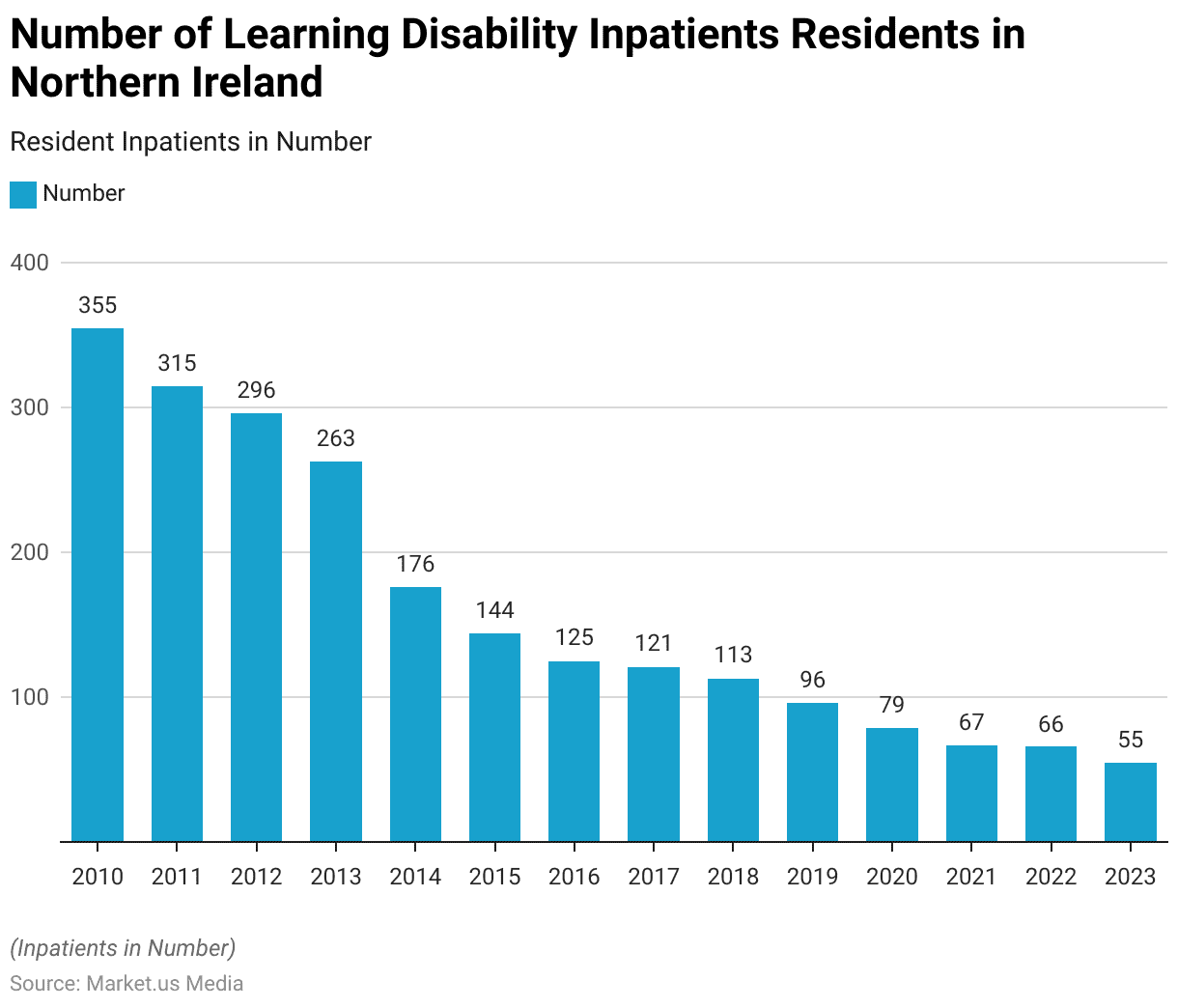
Age Distribution of Learning Disability Inpatients
- In 2023, the number of learning disability inpatients resident in Northern Ireland varied across different age groups.
- The majority of inpatients were in the 19-44 age group, accounting for 36 individuals.
- This was followed by the 45-64 age group, which comprised 13 residents.
- In contrast, there were only four inpatients under the age of 18 and just two inpatients aged 65 years and over.
- These figures highlight a higher prevalence of learning disability inpatients among younger adults compared to both the pediatric and elderly populations in Northern Ireland.
(Source: Statista)
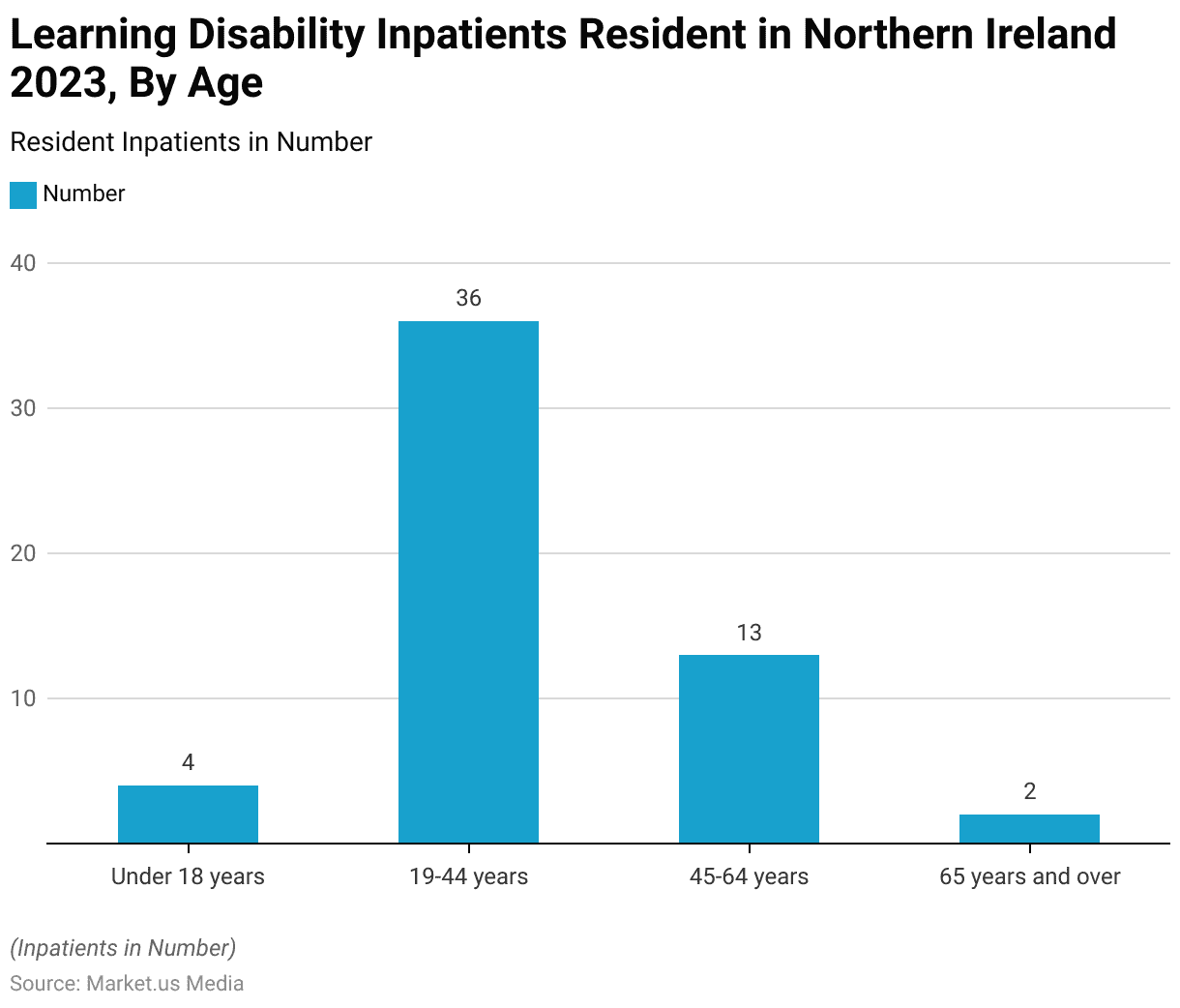
Learning Disabilities Among Children
ADHD or Learning Disabilities Among Children
- Between 2016 and 2018, the prevalence of children aged 3-17 years in the U.S. who were ever diagnosed with ADHD or a learning disability varied by parental educational attainment and ethnicity.
- Among children with parents who had a high school education or less. The overall prevalence was 15.4%, compared to 12.8% for those with parents who had more than a high school education.
- Non-Hispanic white children had the highest prevalence in the high school or less category at 21%, with a lower rate of 13.1% for children with parents having more education.
- Non-Hispanic Black children showed a prevalence of 16.3% when their parents had a high school education or less. Which increased slightly to 16.6% for those with parents having higher education.
- Hispanic children had the lowest prevalence rates, with 11.5% for the high school or less category and 12.2% for the more educated group.
- These findings highlight disparities in ADHD and learning disability diagnoses across different ethnic and educational backgrounds.
(Source: Statista)

ADHD Among Children – By Gender
- Between 2020 and 2022, the prevalence of attention deficit hyperactivity disorder (ADHD) among children in the United States varied by gender.
- During this period, 14.5% of male children were reported to have ever been diagnosed with ADHD, compared to 8% of female children.
- Overall, the total percentage of children diagnosed with ADHD across both genders was 11.3%.
- These figures highlight a higher prevalence of ADHD diagnoses among males compared to females in the U.S.
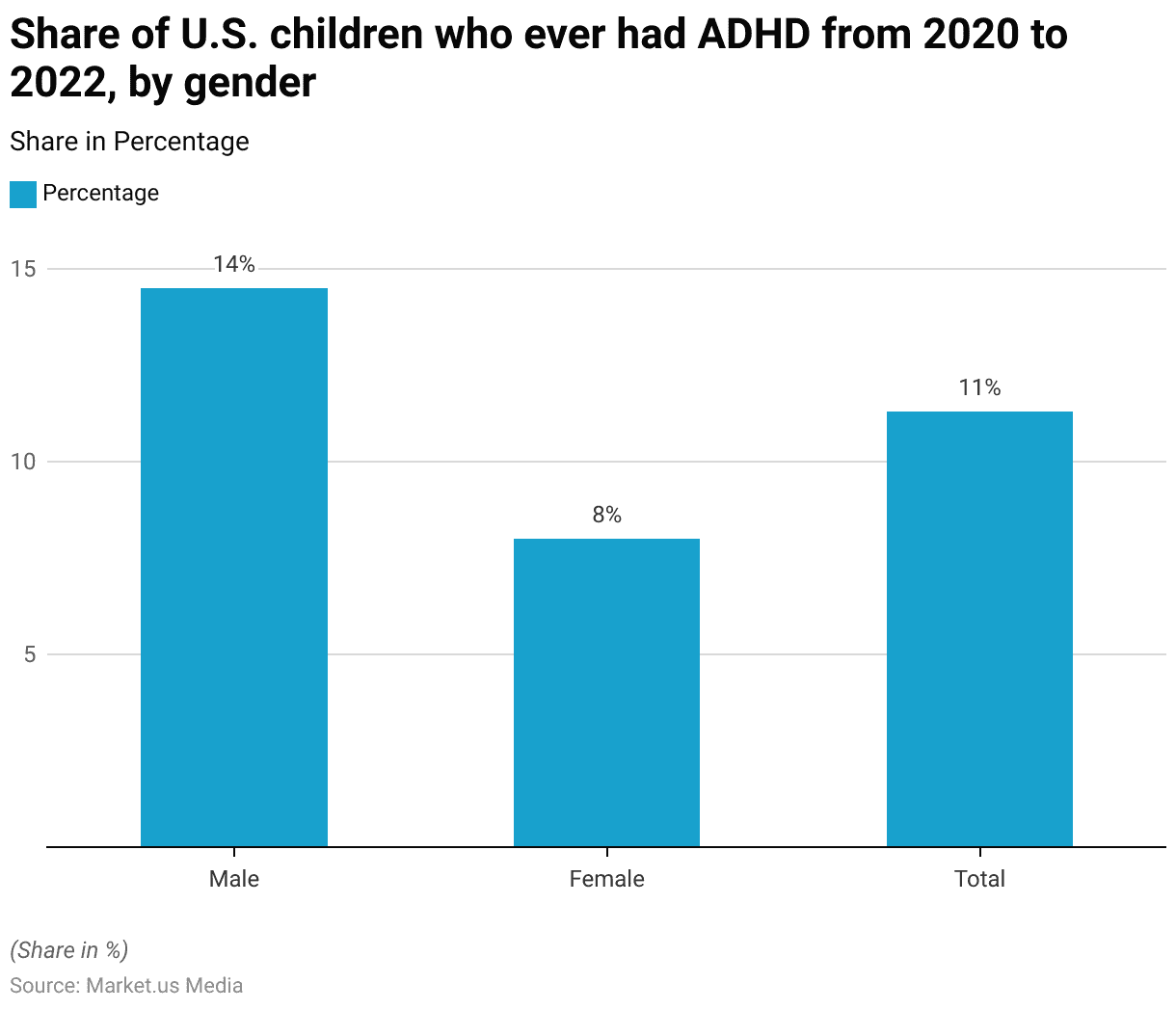
Nurses Working with People with Learning Disabilities and Difficulties
- Between 2009 and 2023, the number of nurses working with people with learning disabilities and difficulties in the NHS Hospitals and Community Health Service (HCHS) workforce in England experienced a steady decline.
- In 2009, there were 5,519 nurses in this specialized field, but this number dropped to 5,083 in 2010 and further decreased to 4,594 in 2011.
- The downward trend continued over the years, with the number falling to 4,288 in 2012, 4,000 in 2013, and 3,775 in 2014.
- By 2015, the figure had declined to 3,646, and it continued to decrease in subsequent years, reaching 3,522 in 2016 and 3,353 in 2017.
- In 2018, the number fell to 3,282 and further declined to 3,250 in 2019.
- From 2020 onwards, the decline slowed slightly, with 3,239 nurses in 2020, 3,106 in 2021, 3,068 in 2022, and a slight reduction to 3,064 in 2023.
- This consistent reduction over the 14 years highlights challenges in maintaining workforce levels in this critical area of healthcare. Emphasizing the need for targeted strategies to address workforce sustainability.
(Source: Statista)
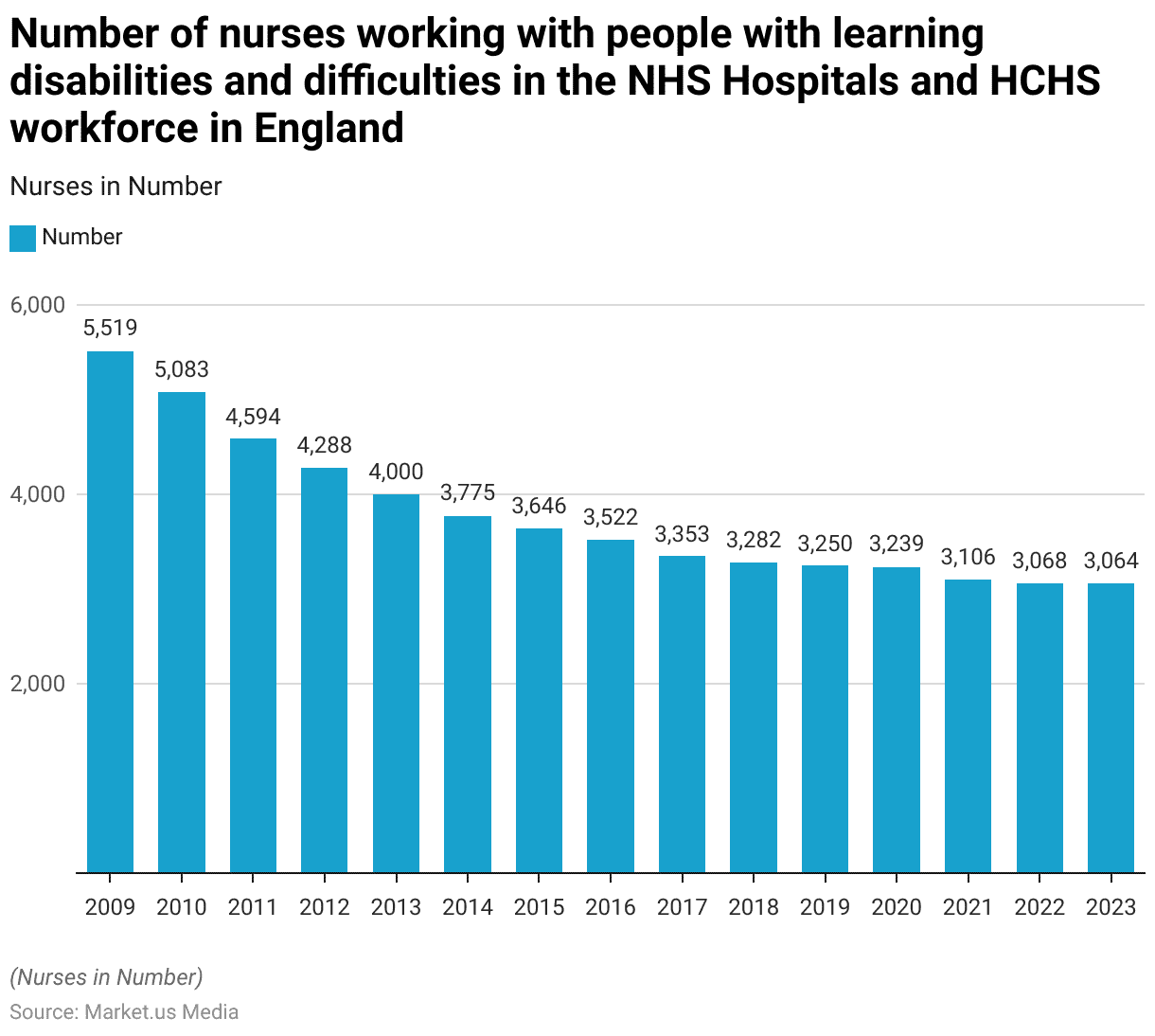
Prevalence of Speech and Language Disorders in Children Statistics
- Understanding speech and language disorders is crucial for increasing awareness and providing early help.
- A study of 5-year-old kindergarten children in the Ottawa-Carleton region showed that, out of 1,655 children tested, 180 had speech or language issues.
- This means that 16.2% to 21.8% of children in the larger population may have similar challenges.
- For boys, the prevalence was estimated at 15.5% to 20.7%, while for girls, it ranged from 19.1% to 25.1%.
- In the U.S., about 8% of children have language delays or disorders.
- Boys are nearly twice as likely as girls to be affected.
- The highest rates of these disorders occur in children between the ages of 3 and 6.
- Experts estimate that around 5% of U.S. children aged 3 to 17 experience a speech problem lasting at least a week.
- By the time children reach first grade, 5% have noticeable speech difficulties, and about 2% deal with voice disorders.
(Source: National Library of Medicine)
Common Speech Disorder Signs in Different Age Groups
- Speech disorders can present differently depending on a child’s age.
- Toddlers (1-3 years) may have a limited vocabulary and find it hard to imitate sounds.
- As children enter the preschool stage (3-5 years), they might struggle with pronouncing words correctly and forming complete sentences.
- By early school age (5-7 years), some children may experience persistent stuttering or have difficulty maintaining the rhythm and flow of their speech. Recognizing these signs early is crucial for timely intervention.
(Source: Connected Speech Pathology)
The Widespread Impact of Speech and Language Disorders on Children and Adults Statistics
- Speech and language disorders can greatly affect both children and adults. In children, these disorders often lead to problems in school, such as trouble understanding lessons and following instructions.
- They may also struggle to communicate with friends, which can hurt their confidence and slow their emotional growth. Not being able to express their thoughts and feelings clearly can cause frustration.
- In adults, more than 3 million people in the U.S. stutter, and about 1 in 4 continue to stutter from childhood into adulthood.
- Voice disorders also affect around 4% of adults. Which can make it harder for them to perform well at work, interact socially, and maintain a good quality of life.
- On a global scale, the number of children with spoken language disorders varies widely. Among children aged 4 to 5, the prevalence ranges from 6.6% to 20.6% in countries like the U.K., Australia, Canada, and Germany.
- For children aged 7 to 11, the rates range from 3.4% to 18.9% in Australia and Germany. These numbers highlight the importance of diagnosing and treating speech and language disorders early.
- Providing access to therapy and support can help individuals improve their communication skills and lead better lives.
(Source: American Speech Language Hearing Association (ASHA))
Speech-Language Pathologists Statistics
Presence of Speech-Language Pathologists
- In the United States, the number of speech-language pathologists was approximately 171,400 in 2022.
- This figure is projected to increase significantly, with an estimated 204,500 speech-language pathologists by 2032.
- This growth highlights the rising demand for professionals in this field. Likely driven by increased awareness and diagnosis of speech and language disorders across different age groups.
(Source: Statista)
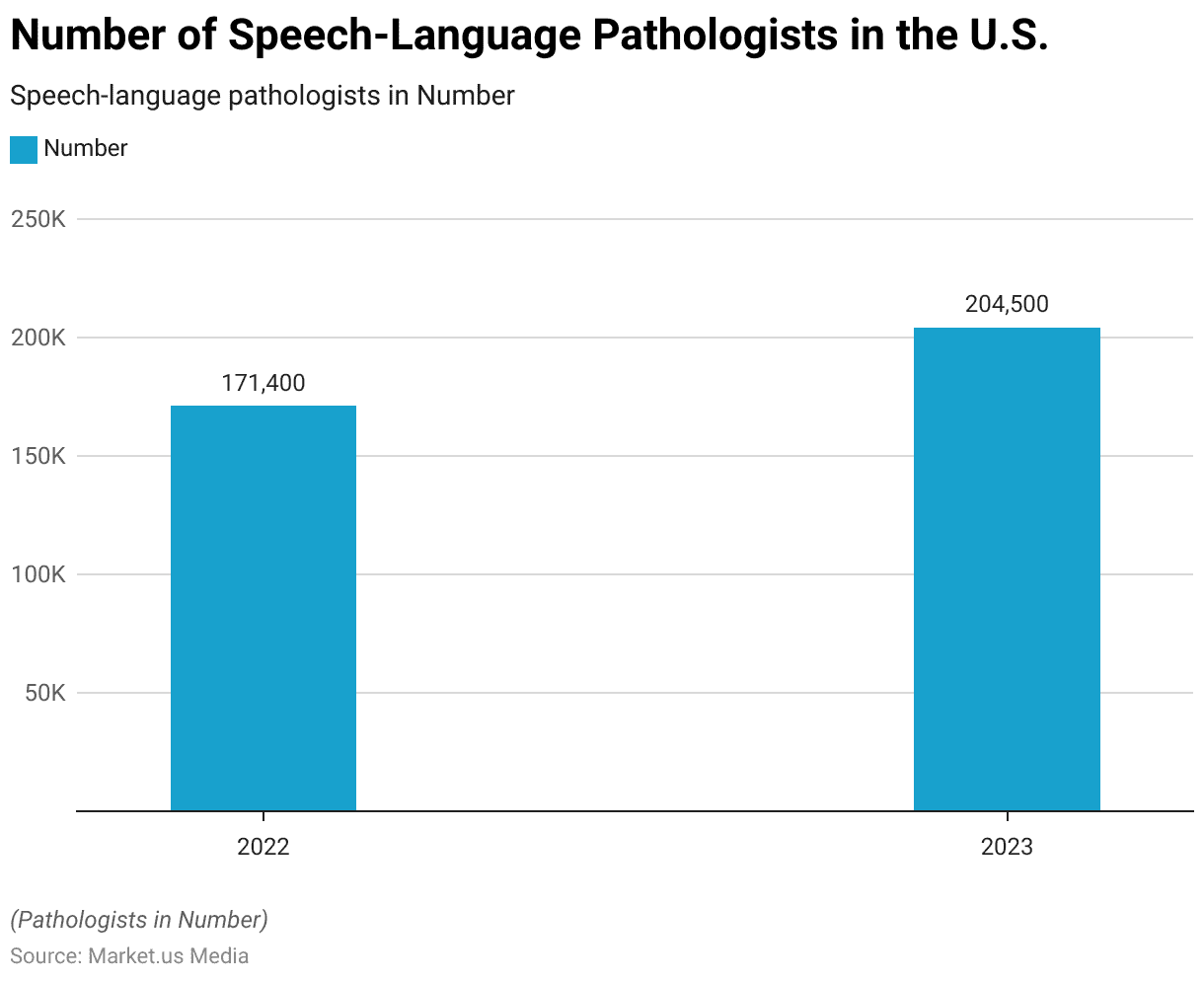
Number of Hours Worked by Speech-Language Pathologists
- The number of hours worked by speech-language pathologists in Israel has steadily increased from 2010/11 to 2022/23.
- In 2010/11, 13,365 hours were recorded, which rose to 16,978 hours by 2012/13.
- The upward trend continued, with 25,081 hours in 2014/15 and 29,081 hours in 2016/17.
- By 2018/19, the number of hours had further increased to 31,880.
- This growth persisted in the following years, reaching 38,054 hours in 2020/21 and culminating at 40,832 hours in 2022/23.
- This consistent rise reflects the growing demand for speech-language pathology services in Israel over the years.
(Source: Statista)

Presence of Speech and Language Therapists
- Between 2010 and 2021, the number of speech and language therapists in the United Kingdom fluctuated but ultimately showed a significant increase.
- In 2010, there were 14,700 therapists, rising slightly to 15,000 in 2011.
- However, the numbers dropped to 13,400 in 2012 and continued to decline, reaching a low of 12,500 in 2014.
- From 2015 onward, the trend reversed, with a gradual increase to 13,600 in 2015 and 15,700 in 2016.
- Although there was a slight dip to 15,300 in 2017 and 14,800 in 2018, the numbers surged in the following years, reaching 18,500 in 2019, 20,300 in 2020, and a peak of 24,900 in 2021.
- This growth highlights a rising demand for speech and language therapy services in the UK.
(Source: Statista)
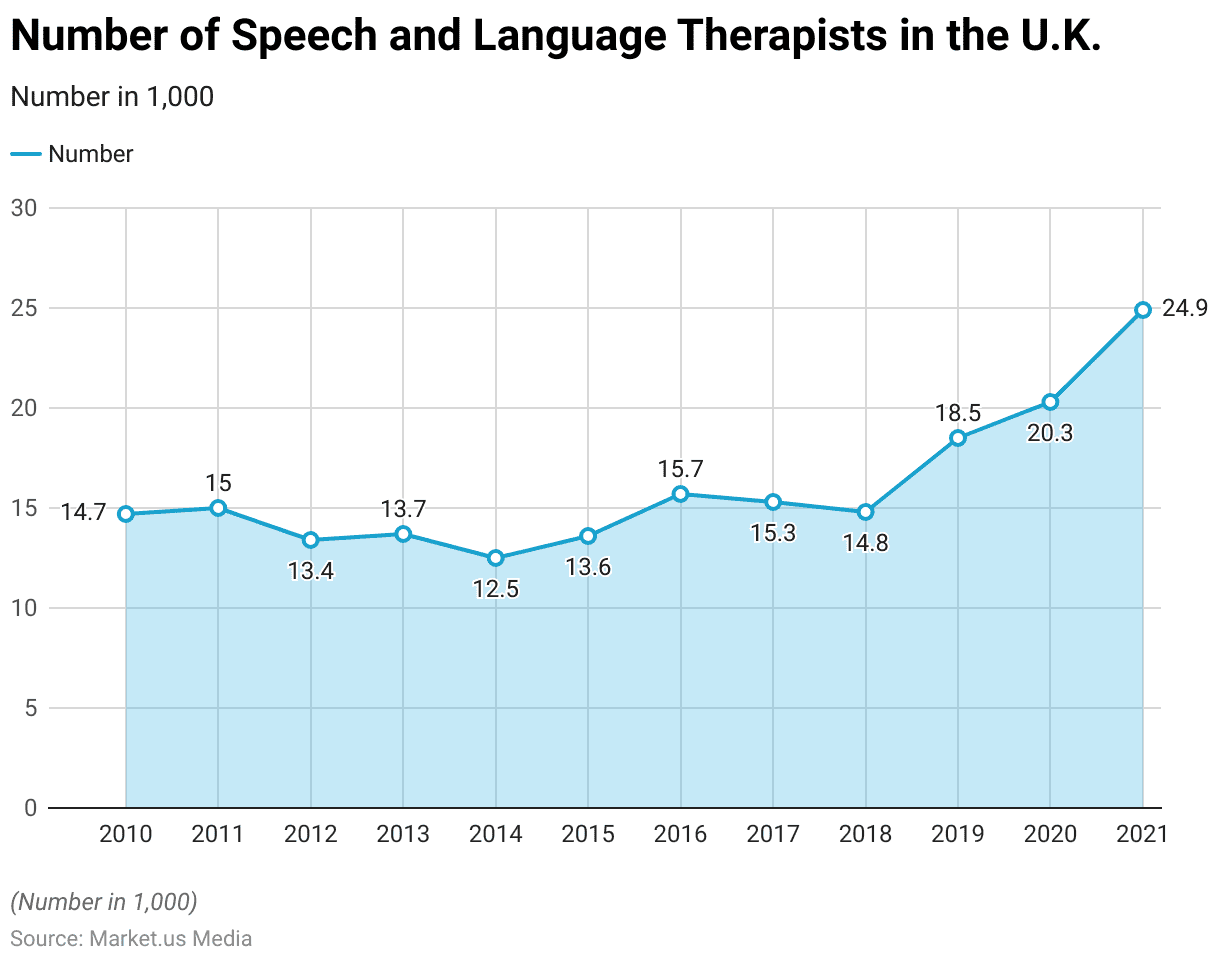
Treatments and Solutions
Speech Therapy
- The speech therapy market in the United States is projected to grow significantly in the coming years.
- In 2024, the market size is expected to reach $4.9 billion.
- By 2031, this figure is forecasted to rise to $8.3 billion, reflecting the increasing demand for speech therapy services.
- This growth may be attributed to greater awareness of speech and language disorders, advancements in therapeutic techniques, and a growing population requiring speech therapy interventions.
(Source: Statista)
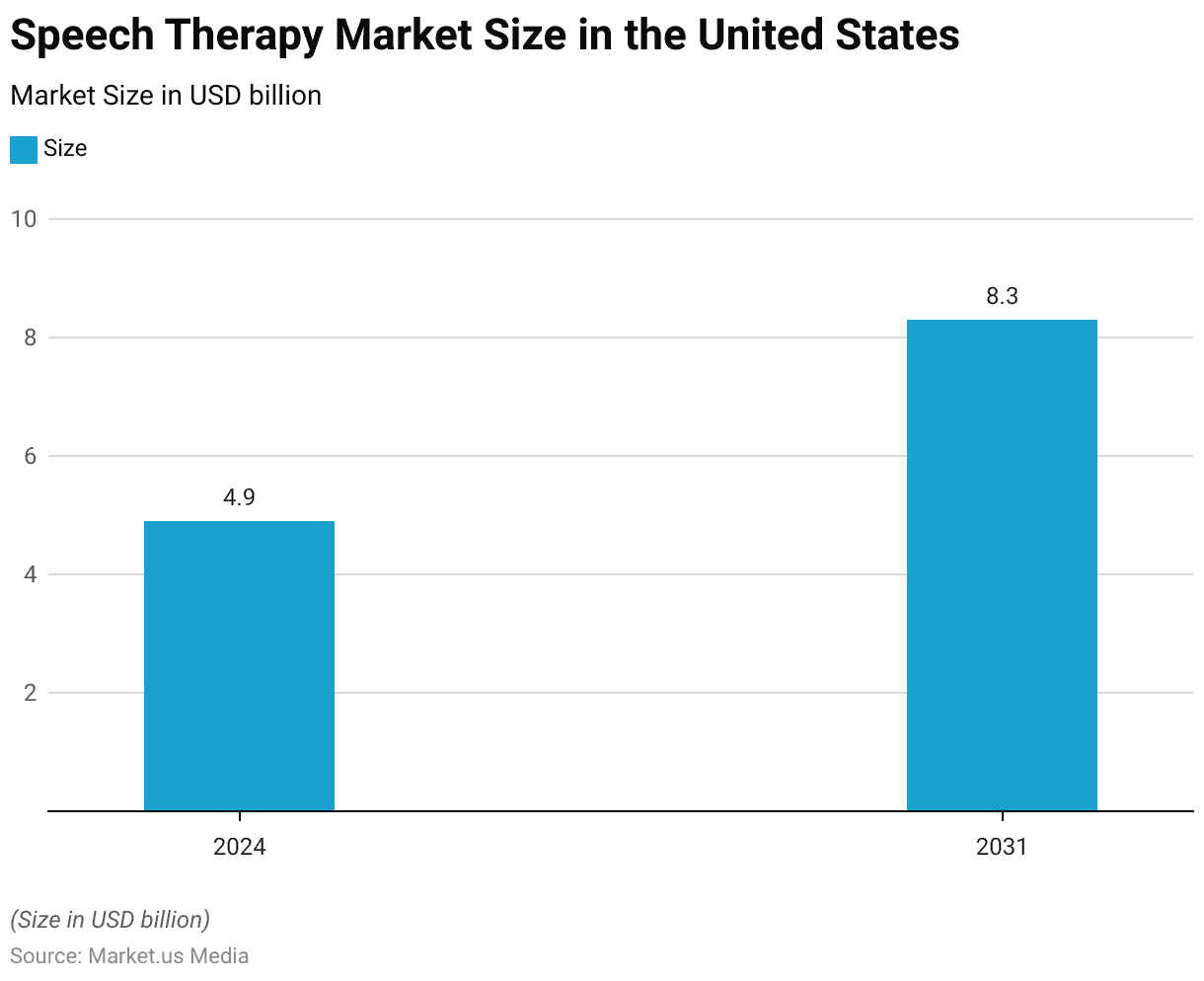
Therapy Received by Veterans
- Between 2019 and 2020, the percentage of U.S. adults who received physical, speech, rehabilitative, or occupational therapy varied by veteran and disability status.
- Among veterans, 33.6% of those with a disability reported receiving therapy, compared to 23.9% without a disability.
- For nonveterans, 11.7% of those with a disability received therapy, while only 8% of those without a disability accessed these services.
- These figures highlight a higher reliance on therapy services among individuals with disabilities, particularly within the veteran population.
(Source: Statista)
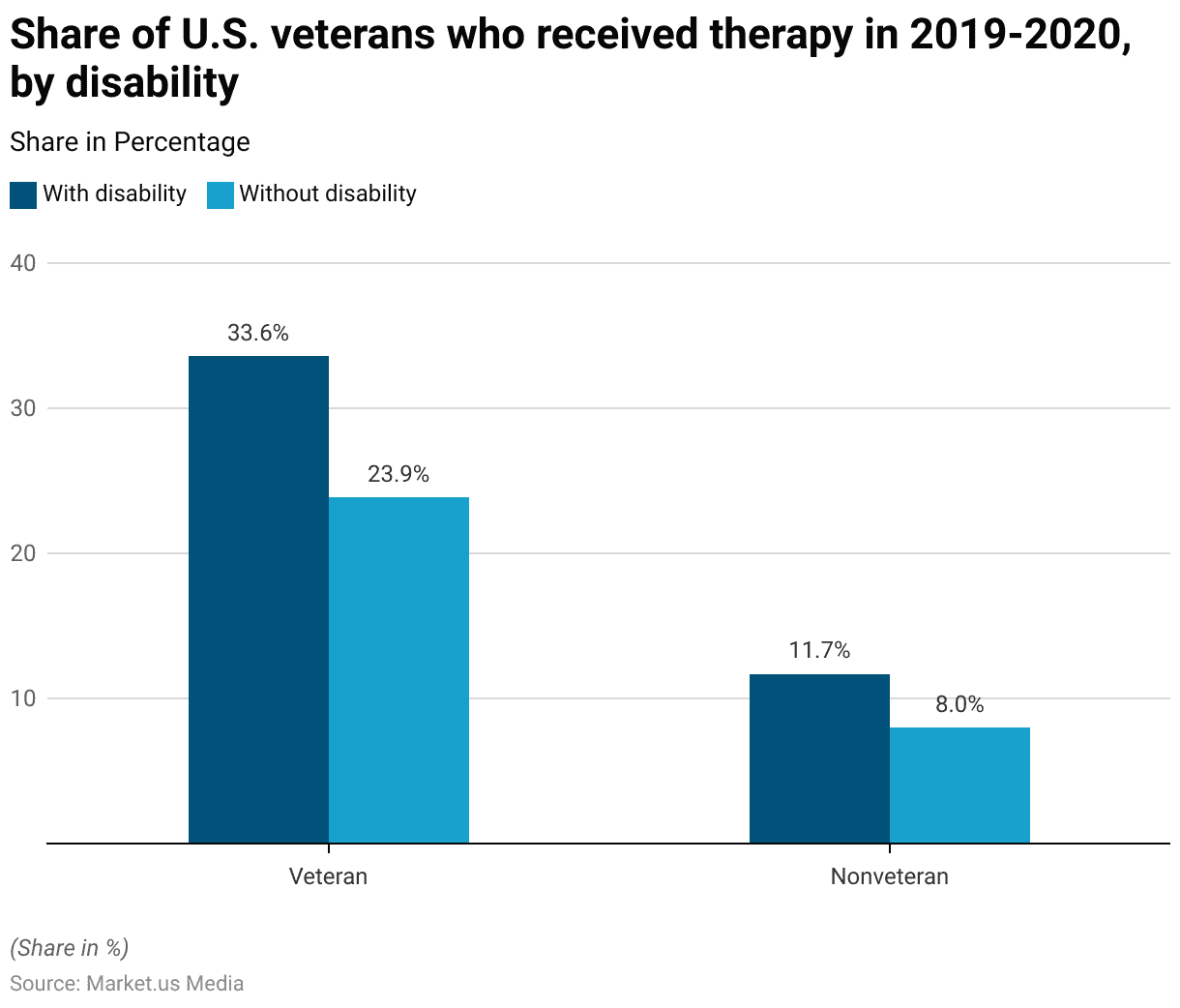
Speech-based NLP Market Size Worldwide
- The global market size of the speech-based segment of natural language processing (NLP) has shown significant growth and is projected to continue its rapid expansion through 2030.
- In 2020, the market was valued at $7.42 billion and increased to $11.12 billion in 2021.
- Although it slightly decreased to $9.43 billion in 2022, it rebounded strongly in 2023, reaching $17.13 billion.
- This upward trajectory is expected to persist, with the market size projected to grow to $21.27 billion in 2024, $28.65 billion in 2025, and $37.95 billion in 2026.
- By 2027, the market is forecasted to reach $49.27 billion, followed by $62.48 billion in 2028.
- The growth is set to accelerate further, with the market size anticipated to hit $78.25 billion in 2029 and an impressive $96.26 billion by 2030.
- These figures highlight the increasing demand for speech-based NLP technologies across various industries.
(Source: Statista)
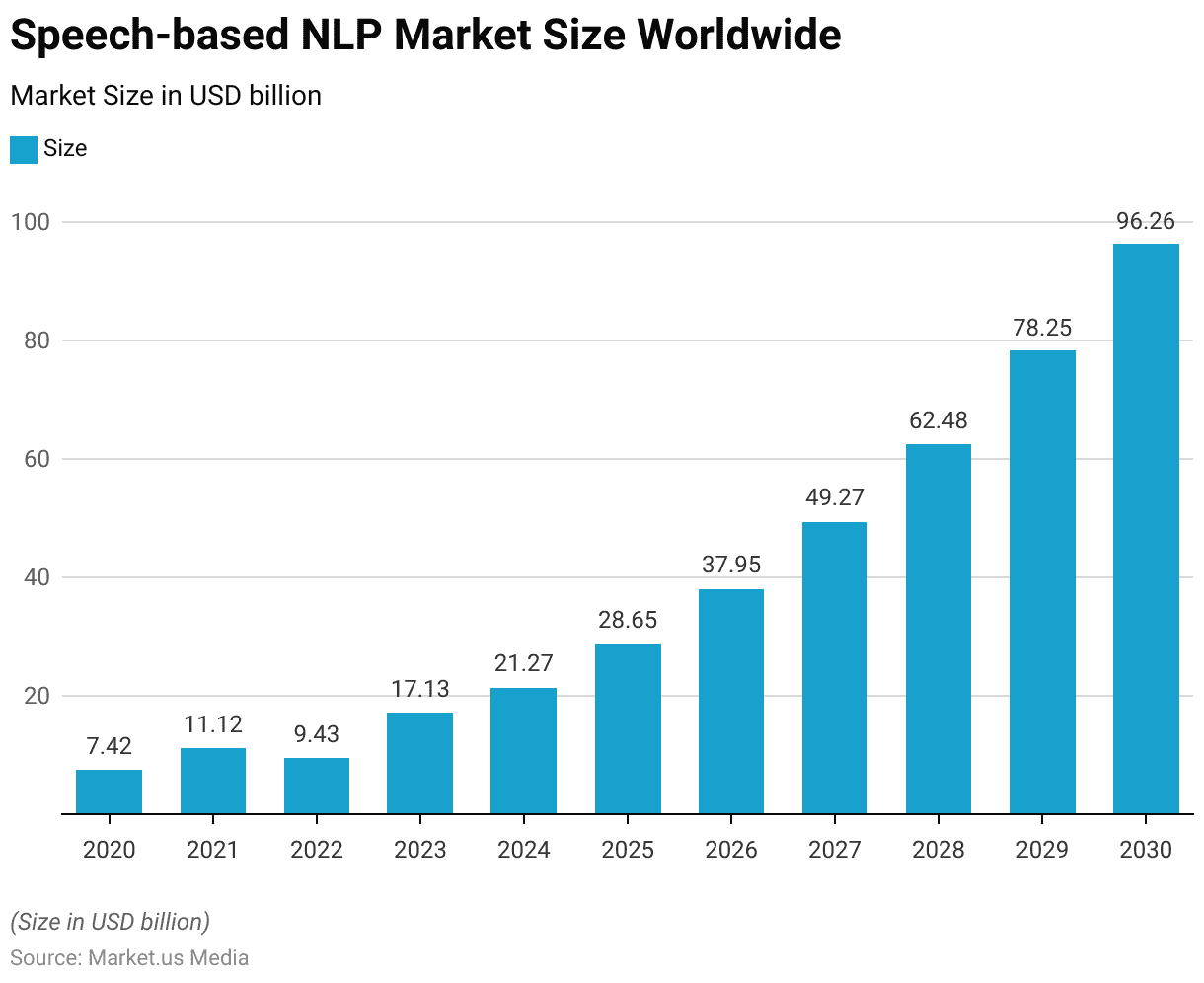
Revenue of Offices of Physical, Occupational, and Speech Therapists
U.S. Industry Revenue of Offices of Physical, Occupational, and Speech Therapists
- The revenue of offices providing physical, occupational, and speech therapy services in the United States has experienced steady growth from 2012 to 2024, with a few fluctuations.
- In 2012, the industry generated $24.5 billion, which slightly decreased to $24.36 billion in 2013.
- The revenue then steadily increased, reaching $26.17 billion in 2014 and $28.36 billion in 2015.
- By 2016, it rose to $30.01 billion, followed by $31.47 billion in 2017 and $33.79 billion in 2018.
- The upward trend continued in 2019, with revenue hitting $34.99 billion.
- However, in 2020, revenue dipped slightly to $33.42 billion, likely due to the impacts of the COVID-19 pandemic.
- The industry rebounded in 2021, reaching $34.98 billion, and the growth persisted in the following years, with revenues of $36.85 billion in 2022 and $39.07 billion in 2023.
- By 2024, the industry is projected to generate $39.85 billion, reflecting the sustained demand for therapy services in the U.S.
(Source: Statista)
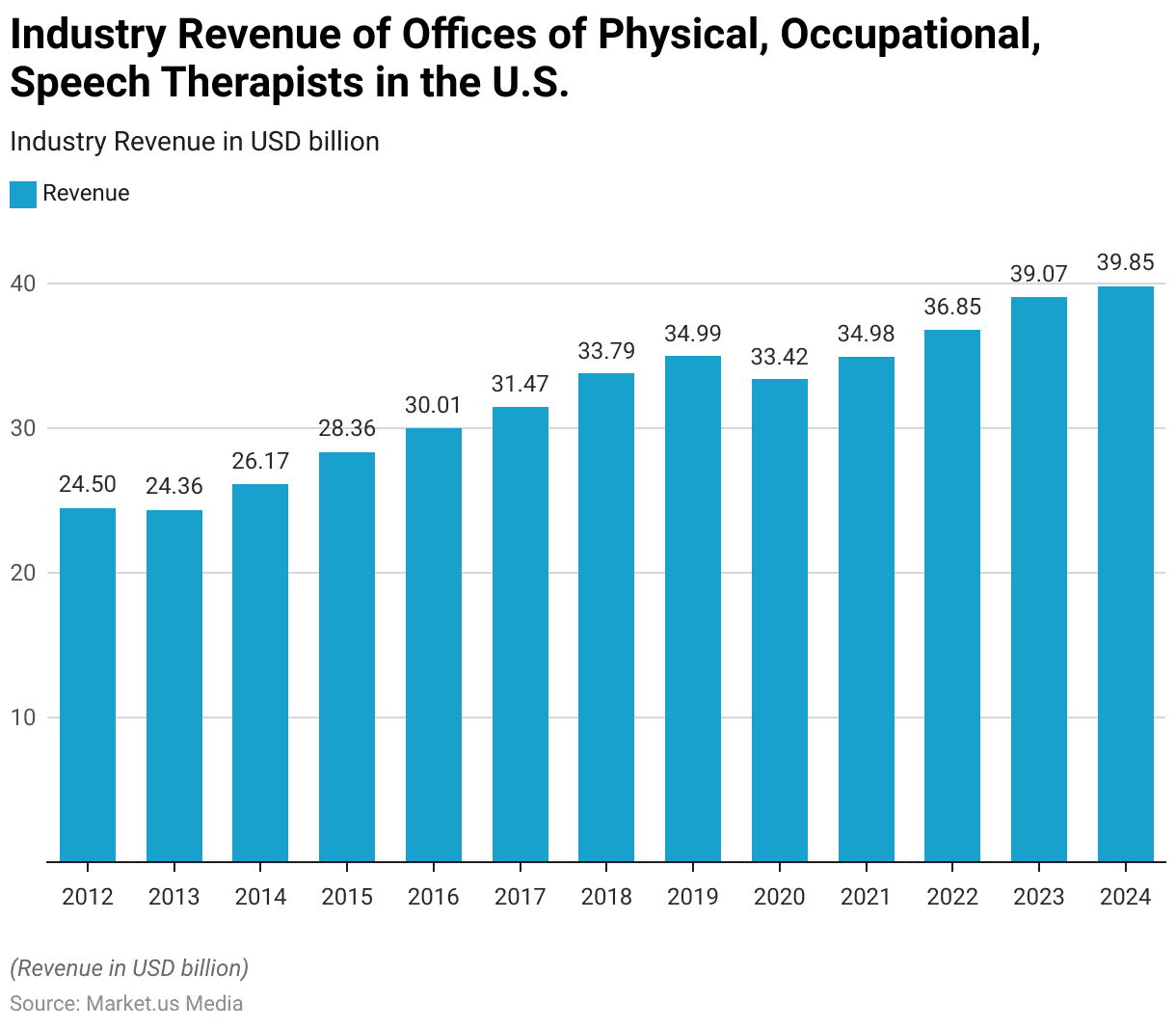
Pennsylvania Industry Revenue of Offices of Physical, Occupational, and Speech Therapists
- The revenue generated by offices of physical, occupational, and speech therapists in Pennsylvania has shown steady growth from 2012 to 2024, with some fluctuations.
- In 2012, the industry earned $1,409.7 million, increasing to $1,449.68 million in 2013 and $1,482.24 million in 2014.
- The revenue continued to grow, reaching $1,507.4 million in 2015 and $1,525.14 million in 2016.
- This upward trend persisted through 2017 and 2018, with revenues of $1,535.48 million and $1,555.52 million, respectively.
- In 2019, the industry peaked at $1,572.69 million before experiencing a decline in 2020, dropping to $1,467.61 million, likely due to the impacts of the COVID-19 pandemic.
- The industry rebounded in 2021 with revenue of $1,505.11 million and continued its recovery in 2022, reaching $1,558.19 million.
- Growth accelerated in 2023, with revenues hitting $1,627.26 million, and is projected to reach $1,637.98 million in 2024.
- This consistent growth underscores the increasing demand for therapy services in Pennsylvania over the years.
(Source: Statista)
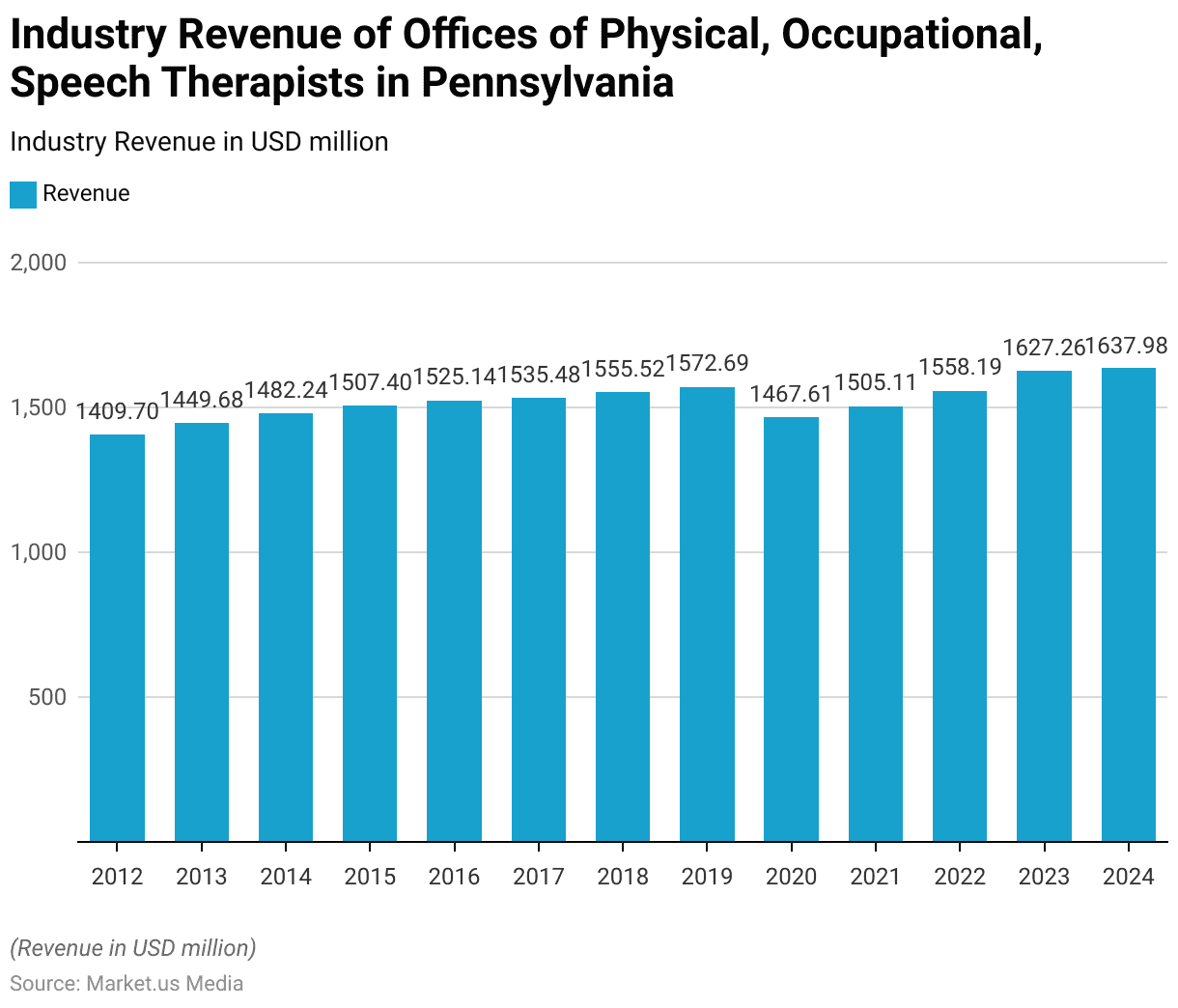
Ohio Industry Revenue of Offices of Physical, Occupational, and Speech Therapists
- The revenue generated by offices of physical, occupational, and speech therapists in Ohio has shown consistent growth from 2012 to 2024, with a brief dip in 2020.
- In 2012, the industry earned $799.4 million, which increased steadily to $831.78 million in 2013 and $864.22 million in 2014.
- By 2015, revenue had risen to $896.74 million, followed by $929.36 million in 2016 and $962.06 million in 2017.
- The upward trend continued through 2018, reaching $985.35 million, and surpassed the $1 billion mark in 2019 with $1,007.19 million.
- However, 2020 saw a decline, with revenue dropping to $949.01 million, likely due to the effects of the COVID-19 pandemic.
- The industry rebounded in 2021, with revenue rising to $981.61 million, and the growth persisted in subsequent years.
- In 2022, the industry generated $1,023.96 million, increasing to $1,076.59 million in 2023.
- By 2024, revenue is projected to reach $1,090.22 million, reflecting sustained demand for therapy services in Ohio.
(Source: Statista)

Georgia Industry Revenue of Offices of Physical, Occupational, and Speech Therapists
- The revenue generated by offices of physical, occupational, and speech therapists in Georgia has shown consistent growth from 2012 to 2024.
- In 2012, the industry earned $547.86 million, which increased to $579.8 million in 2013 and $611.71 million in 2014.
- This upward trend continued, with revenues reaching $643.6 million in 2015, $675.47 million in 2016, and $707.3 million in 2017.
- By 2018, the revenue had grown to $730.17 million, and it further increased to $751.59 million in 2019.
- Despite the challenges posed by the COVID-19 pandemic, the industry continued to expand, generating $771.08 million in 2020 and $788.82 million in 2021.
- This growth persisted in subsequent years, with revenues of $804.96 million in 2022 and $819.65 million in 2023.
- By 2024, the revenue is projected to reach $833.01 million, reflecting the sustained demand for therapy services in Georgia over the years.
(Source: Statista)
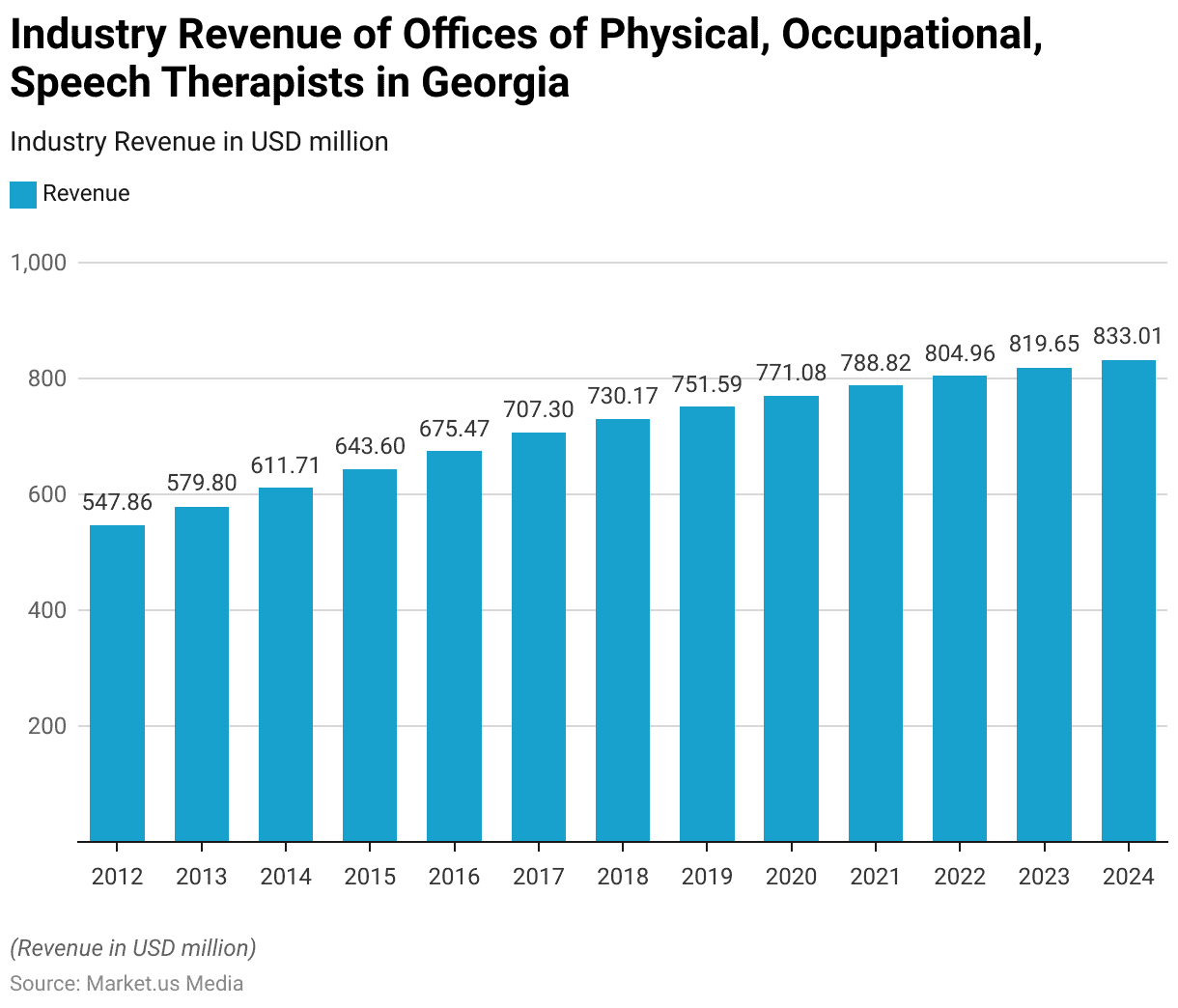
New York Industry Revenue of Offices of Physical, Occupational, and Speech Therapists
- The revenue of offices providing physical, occupational, and speech therapy services in New York has steadily increased from 2012 to 2024, with a minor dip in 2020.
- In 2012, the industry generated $1,856.13 million, which grew to $1,952.18 million in 2013 and surpassed $2 billion in 2014 with $2,051.97 million.
- The growth continued in 2015 with $2,155.50 million and reached $2,262.78 million in 2016.
- By 2017, revenue rose to $2,373.80 million and increased further to $2,446.98 million in 2018 and $2,516.38 million in 2019.
- The industry faced a slight decline in 2020, with revenue dropping to $2,383.49 million, likely due to the COVID-19 pandemic.
- However, it rebounded in 2021, reaching $2,476.68 million, and continued to grow in subsequent years, with $2,593.92 million in 2022 and $2,736.90 million in 2023.
- By 2024, the revenue is projected to hit $2,780.20 million, reflecting the increasing demand for therapy services in New York.
(Source: Statista)
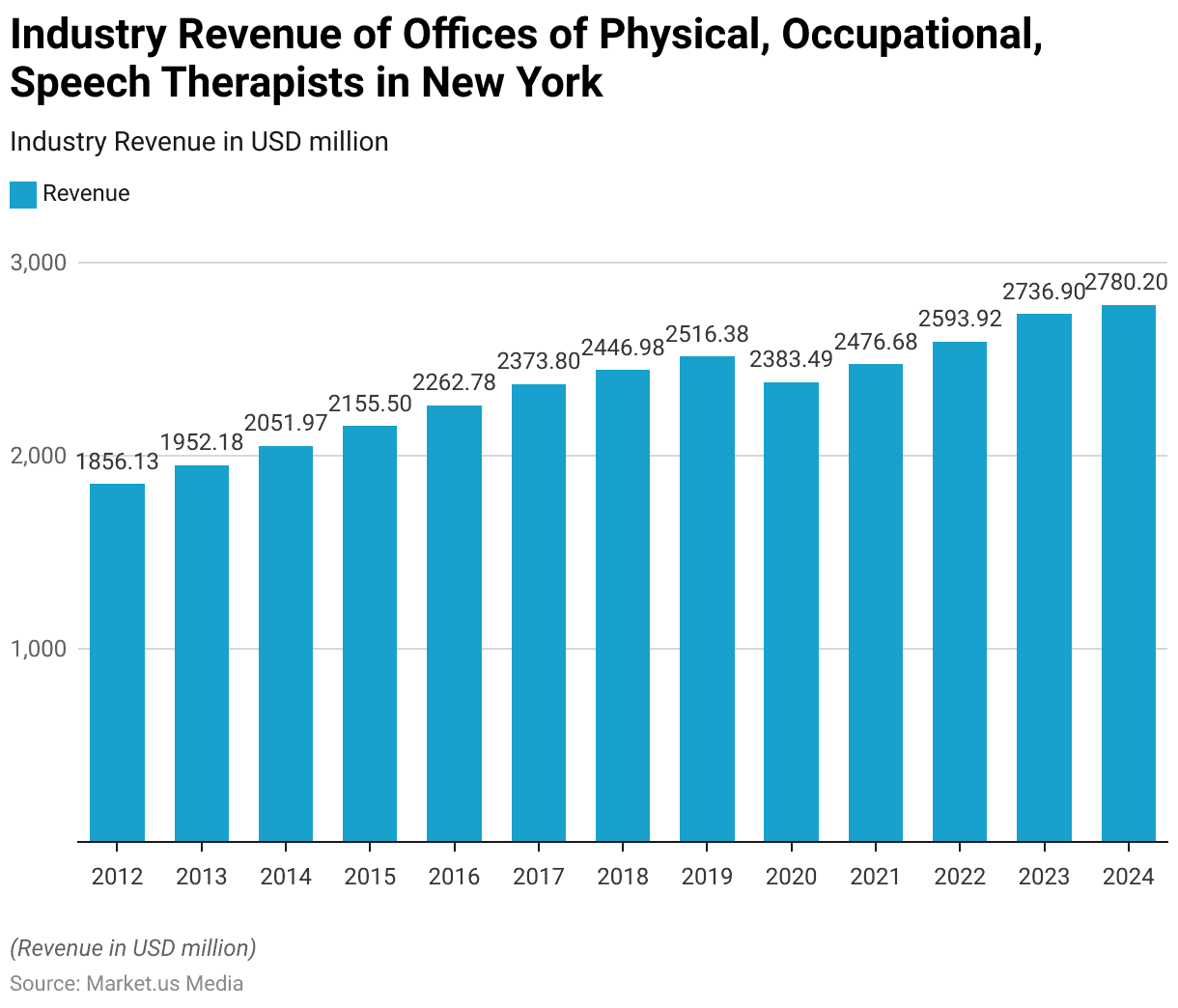
California Industry Revenue of Offices of Physical, Occupational, and Speech Therapists
- The revenue of offices providing physical, occupational, and speech therapy services in California has shown consistent growth from 2012 to 2024, with a temporary decline in 2020.
- In 2012, the industry generated $2,185.76 million, increasing to $2,294.55 million in 2013 and $2,414.11 million in 2014.
- This upward trend continued, with revenue reaching $2,544.43 million in 2015 and $2,685.50 million in 2016.
- By 2017, revenue rose to $2,837.34 million and further increased to $2,927.82 million in 2018 and $3,014.95 million in 2019.
- In 2020, revenue dipped to $2,859.08 million, likely due to the impact of the COVID-19 pandemic.
- However, the industry quickly rebounded, generating $2,973.87 million in 2021 and continuing its growth to $3,117.42 million in 2022 and $3,291.80 million in 2023.
- By 2024, the revenue is projected to reach $3,346.17 million, reflecting sustained demand for therapy services across California.
(Source: Statista)
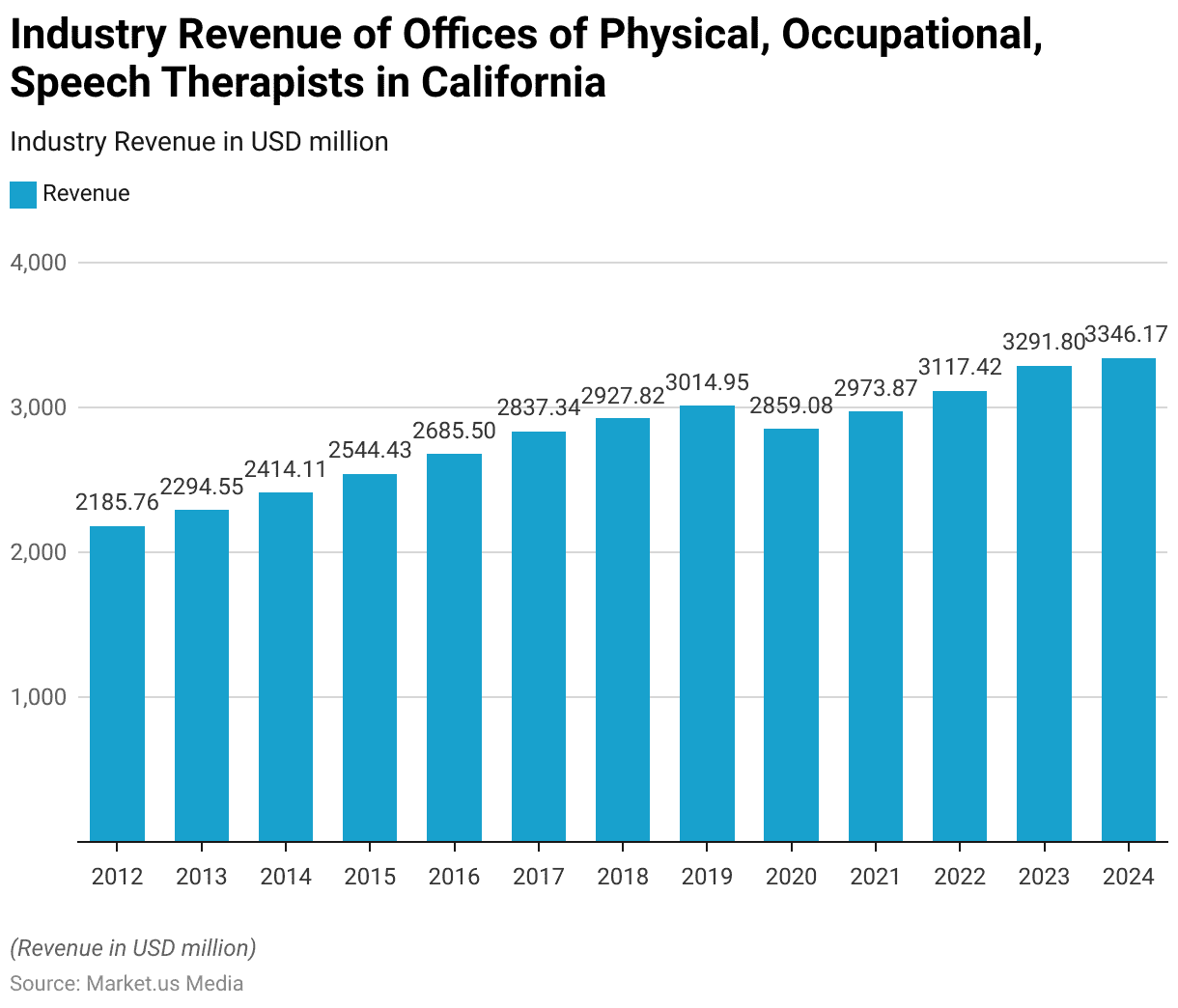
Texas Industry Revenue of Offices of Physical, Occupational, and Speech Therapists
- The revenue generated by offices of physical, occupational, and speech therapists in Texas has shown steady growth from 2012 to 2024, with a slight dip in 2020.
- In 2012, the industry earned $2,119.02 million, which rose to $2,273.62 million in 2013 and $2,433.71 million in 2014.
- This growth continued over the next few years, reaching $2,599.29 million in 2015, $2,770.36 million in 2016, and $2,946.92 million in 2017.
- By 2018, revenue had grown to $3,064.11 million, and in 2019, it increased further to $3,175.12 million.
- In 2020, revenue slightly declined to $3,072.15 million, likely due to the impacts of the COVID-19 pandemic.
- However, the industry recovered in 2021, with revenue climbing back to $3,163.29 million, and continued its upward trajectory in 2022, reaching $3,329.30 million.
- By 2023, the revenue grew to $3,527.85 million and is projected to hit $3,597.12 million in 2024, reflecting ongoing demand for therapy services in Texas.
(Source: Statista)

Initiatives to Combat Speech and Language Disorders Statistics
- In response to the global challenge of speech and language disorders, various organizations and countries have launched extensive initiatives aimed at improving support and interventions for those affected.
- For instance, UNICEF‘s Regional Office for Europe and Central Asia has piloted an initiative in Croatia, Montenegro, and Serbia to provide affordable Assistive Technology for Augmentative and Alternative Communication (AAC) to children.
- This effort includes training over 70 professionals and has impacted 125 children since its inception in November 2019.
- In the UK, the “Listening to Unheard Children” report by Speech and Language UK highlights the urgent need for support among 1.9 million children struggling with speech and language.
- This initiative advocates for nationwide training for educators and early years practitioners to better identify and support children facing these challenges.
- Similarly, the National Institutes of Health in the US launched the Tackling Acquisition of Language in Kids (TALK) initiative in 2023, focusing on late-talking children.
- This program is a multi-institute effort that aims to create and utilize longitudinal data sets to understand better and address the needs of children with delayed language skills.
- Furthermore, the World Health Organization’s World Report on Hearing, first released on World Hearing Day, emphasizes the need for a global response to hearing and speech disorders.
- The report outlines a comprehensive public health strategy to enhance ear and hearing care. This is critical as hearing loss is a significant contributor to speech and language difficulties. This approach includes screening, intervention, and access to necessary technologies.
- Each of these programs reflects a strong commitment to enhancing the understanding, support, and intervention strategies for speech and language disorders across different regions and populations. Illustrating a proactive approach to addressing these critical developmental challenges.
(Source: Speech And Language UK, Unicef, Nidcd)
Recent Developments
Acquisitions and Mergers:
- SonderMind’s Acquisition of Teletherapy: In November 2023, SonderMind acquired Teletherapy, a virtual speech therapy platform, in a deal valued at approximately $35 million.
- This strategic move expands SonderMind’s offerings to include speech therapy services. Aiming to serve over 10,000 new patients annually, particularly children and families in need.
Product Launches:
- Constant Therapy’s Enhanced Digital Platform: In January 2023, Constant Therapy introduced an upgraded version of its speech and cognitive therapy platform, now used by over 50,000 patients globally.
- The platform offers over 100,000 personalized exercises and tracks patient progress in real time, enhancing engagement and outcomes.
Funding:
- Express Scripts’ Partnership with ASHA: In December 2023, Express Scripts committed $15 million to its partnership with the American Speech-Language-Hearing Association (ASHA).
- This collaboration aims to expand access to qualified speech-language pathologists. Targeting a 20% increase in service availability for their 30 million members.
Conclusion
Speech and Language Disorders Statistics – Speech and language disorders affect individuals of all ages. Impacting communication, academic performance, social interactions, and overall quality of life.
Early diagnosis and intervention are essential, particularly for children, to help them develop critical communication skills.
In adults, these disorders can hinder professional and social opportunities, highlighting the need for ongoing support.
Globally, the rising prevalence of speech and language disorders emphasizes the importance of accessible services and effective treatment to improve outcomes and enhance the quality of life for those affected.
FAQs
Speech and language disorders refer to difficulties in communication. Including problems with producing sounds, understanding or using language, and voice quality. They can affect speech clarity, fluency, or the ability to express thoughts.
These disorders can be caused by a variety of factors, including genetic conditions, hearing loss, developmental delays, brain injuries, or neurological disorders. Environmental factors, such as limited exposure to language, may also contribute.
Speech-language pathologists (SLPs) evaluate a person’s communication skills through standardized tests, observation, and interviews with the individual and their family. Diagnosis involves assessing speech, language, voice, and fluency.
Speech and language disorders can affect individuals of any age, from young children learning to speak to adults who may develop communication issues later in life due to injury, illness, or aging.
Yes, treatment typically involves speech therapy provided by SLPs. Therapy is tailored to the individual’s needs and may focus on improving speech clarity, language comprehension, or other communication skills.
Discuss your needs with our analyst
Please share your requirements with more details so our analyst can check if they can solve your problem(s)



